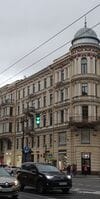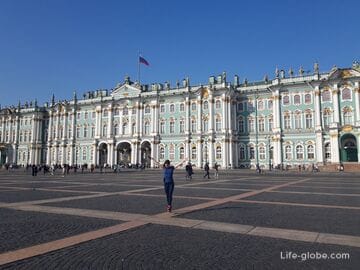Nevsky Prospekt is the main thoroughfare and one of the most popular streets in St. Petersburg, which has a rich history.
Today, Nevsky Prospekt is home to a large number of attractions, including historic buildings, palaces, squares, gardens, cathedrals, and bridges.
Since Nevsky Prospekt is large and has many interesting objects, for the convenience of readers, the description of the avenue is divided into three separate articles:
1. A brief description and history of Nevsky Prospekt, as well as the sights of the most refined and visited part of Nevsky Prospekt-from Alexander Garden to Anichkov Bridge of the Fontanka River (Beloselsky-Belozersky Palace and Literary House). Learn more about the first part of Nevsky Prospekt…
2. The second part, which describes Nevsky Prospekt from the Beloselsky-Belozersky Palace and the Literary House to the Vosstaniya Square inclusive. At Vosstaniya Square, the so-called front part of the avenue ends. Learn more about the second part of Nevsky Prospekt…
3. This article describes Nevsky Prospekt from Vosstaniya Square to the end of the avenue-Alexander Nevsky Square and the Holy Trinity Alexander Nevsky Lavra. This part of the avenue is unofficially called "Staro-Nevsky Prospekt".
Nevsky Prospekt from Vosstaniya Square to Alexander Nevsky Square (Staro-Nevsky Prospekt)
This segment of Nevsky Prospekt is 1.5 kilometers.
Why Staro-Nevsky Prospekt?!
Initially, the suburb of St. Petersburg began behind the Fontanka River, where the first and largest monastery of the city - today the Alexander Nevsky Lavra-was located among the forest and a few buildings. From the monastery to the city center there was a road called "Perspektivnaya Road to the Nevsky Monastery", which was mainly used by the monks.
When the city grew, and the avenue began to turn into a "Front Street", then at first they improved the appearance of the street from Fontanka to the city center.
In the 1730s, to straighten the avenue, it was built along modern Goncharnaya and Bogie Streets, and the original section of the road was named "Staraya Nevskaya Perspektivnaya Street" or "Staro-Nevsky". However, this failed, and the avenue was returned to its original location. However, the name of the part of the avenue in everyday life was fixed-Staro-Nevsky Prospekt. And on the site of the former New Perspektivnaya Street, Goncharnaya and Bogie Streets subsequently appeared, which still exist today.
"Staro-Nevsky Prospekt" today
Behind Vosstaniya Square, along Nevsky Prospekt, buildings stretch in dense rows, some of which are particularly "bright".
This part of Nevsky Prospekt is less lively and attractive than the part of the avenue from the beginning to the Vosstaniya Square.
The historic, now restored buildings contain shops and salons, cafes, bars and restaurants, residential and office premises, as well as accommodation facilities (hotels, apartments)
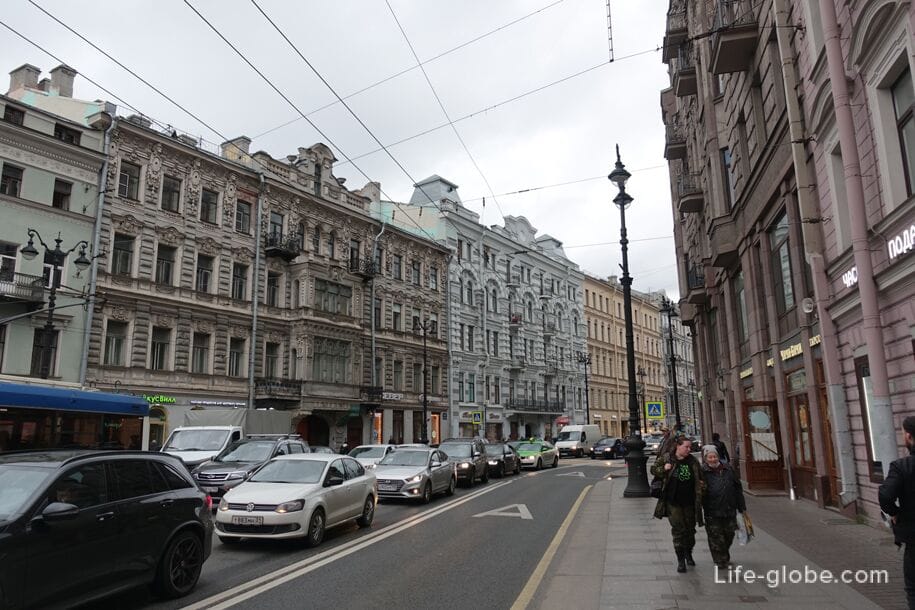
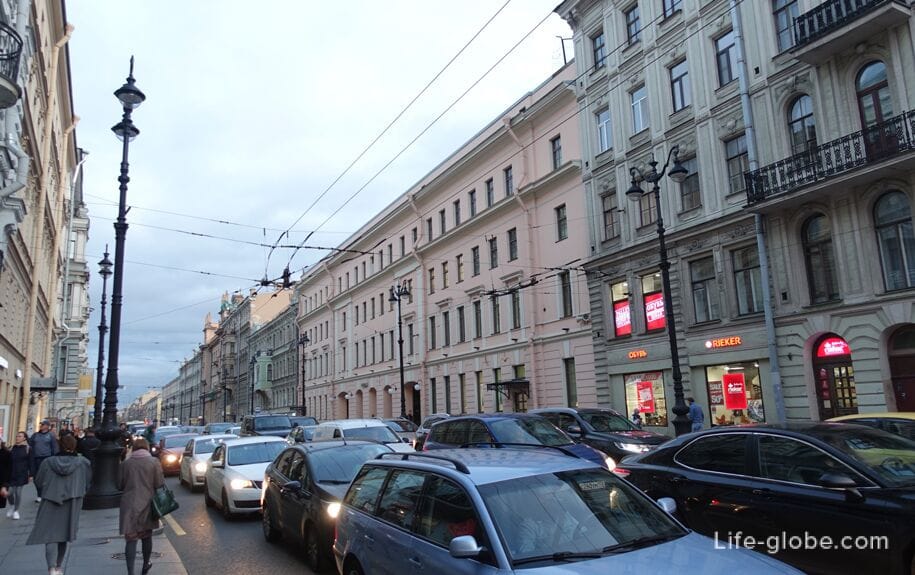

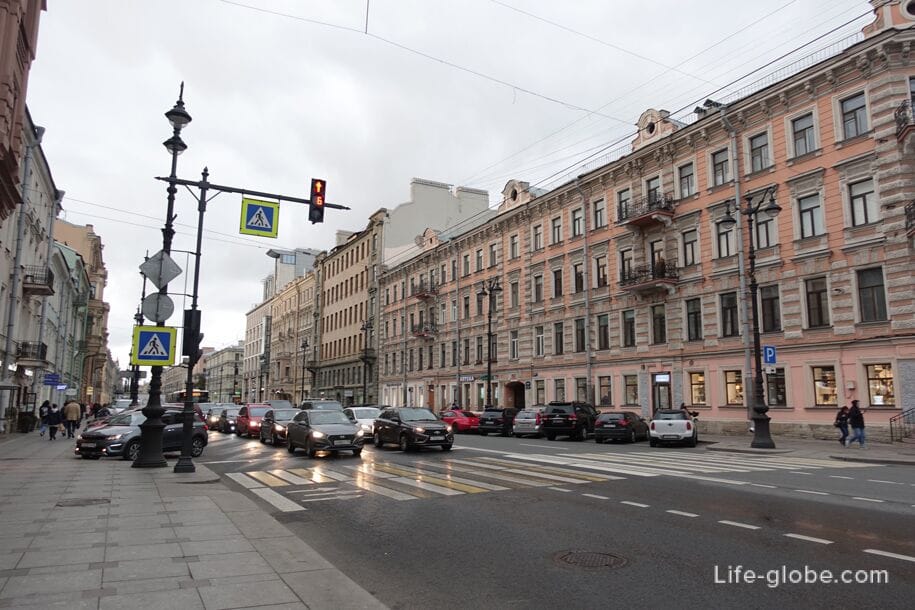
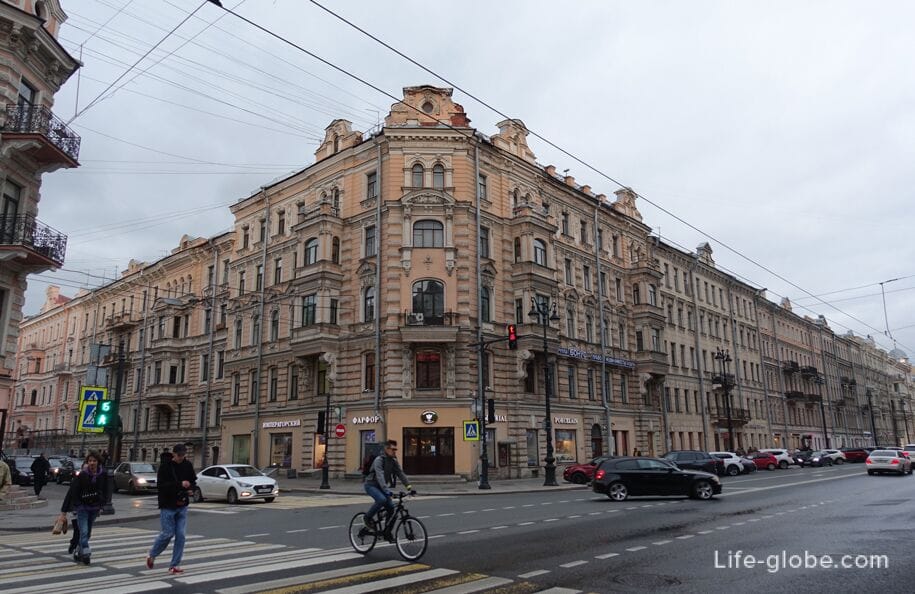
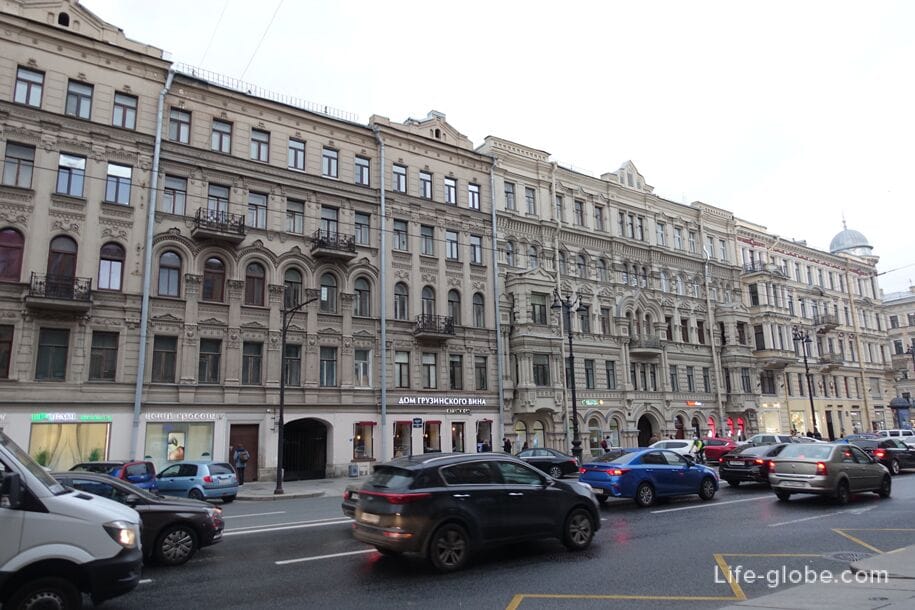
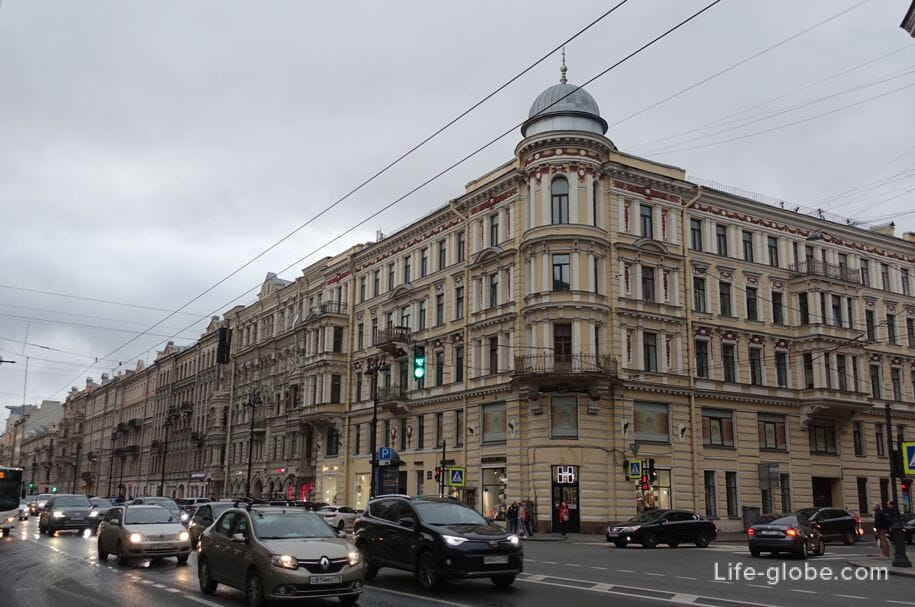
Apartment houses of A. Timofeev (K.A. Tura)
Apartment houses of A. Timofeev (or apartment houses of K.A. Tura) - the house facing Vosstaniya Square, Nevsky Prospekt (No. 87) and Goncharnaya Street (No. 2), was built in the late 18th century.
In 1823, the building belonged to the merchant A. Timofeev and was expanded in the direction of Nevsky Prospekt to a three-story building. In 1867, the plot belonged to the furniture manufacturer K.A. Tur, under whom the house was rebuilt according to the project of the architect G.M. Bartsch with a bay window on the side of Nevsky Prospekt.
Before the revolution, the building housed the Balabinskaya Hotel.
On the roof of the building on the side of Vosstaniya Square there is an electronic screen.
Photo of the house from the side of Vosstaniya Square
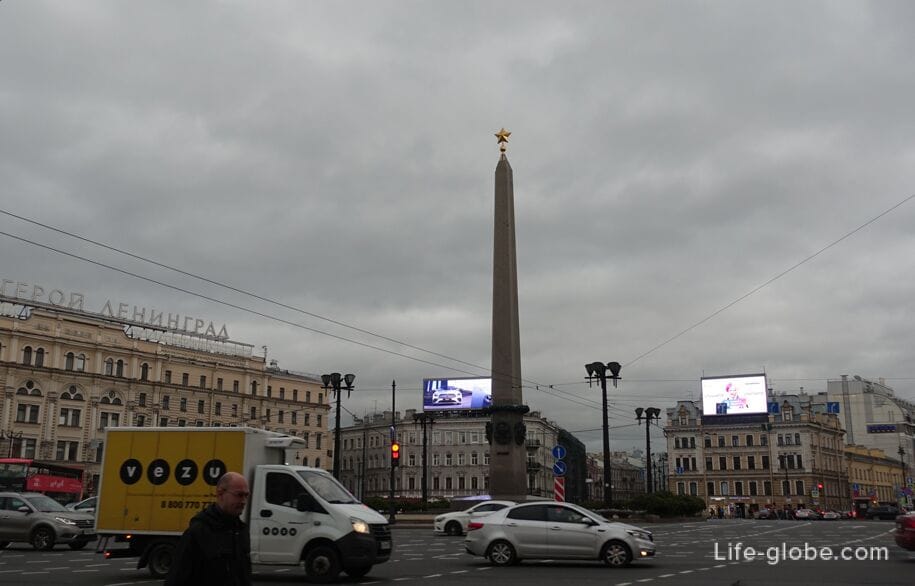
Photo of a house with a bay window on the side of Nevsky Prospekt
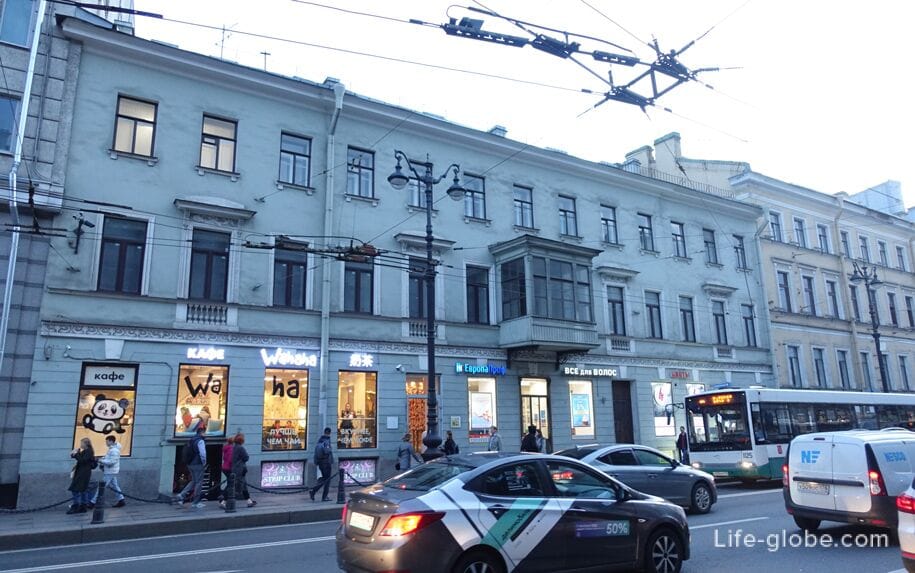
Apartment house of A.N. Chvanova (124 Nevsky Prospekt)
In the middle of the 19th century, this site belonged to an honorary citizen Vasily Mikhailovich Krasilov.
In 1865-1870, the merchant of the 2nd guild Gerasim Ivanovich Chvanov rented part of the house for a hotel, and later purchased the entire house, which after his death in 1879 was inherited by his widow Anastasia Nikolaevna. In 1890, the construction technician F.N. Sobolevsky built a three-story house for A.N. Chvanova.
Subsequently, the building changed owners and residential apartments and various institutions were located within its walls.
During the restoration after the Great Patriotic War, the house was built over with a residential attic floor.
Currently, the building is distinguished by a bay window on the side facade and has an eclectic style.
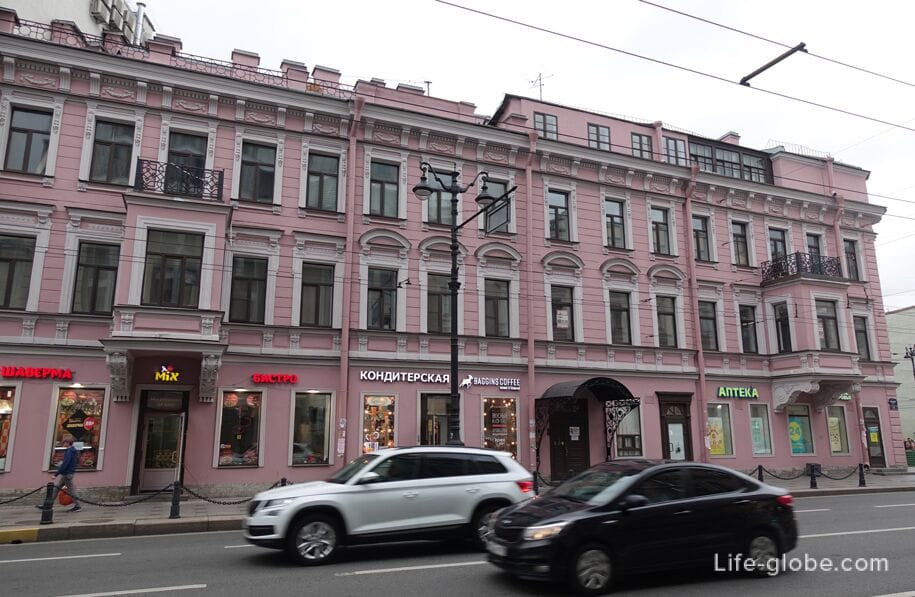
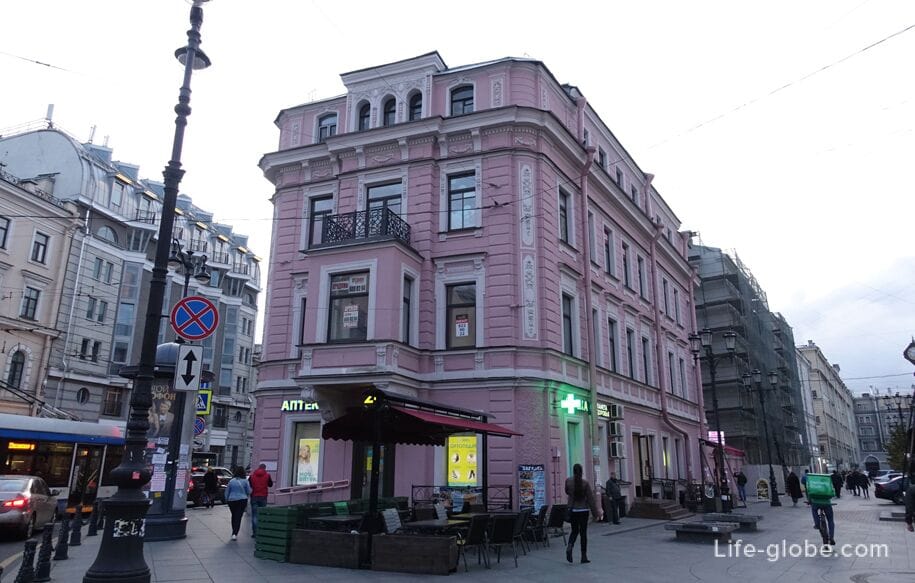
Monument to the carriage
On the 1st Sovetskaya Street (near Nevsky Prospekt) there is a monument to the carriage (the legendary proletka). The monument is made of bronze and is a carriage carriage.
Above the carriage, on a bronze tripod made in the form of cables, there is a clock that is connected to the Glonass system - the mechanism is Swiss, does not require winding, the time is set by satellite.
And they also say that this carriage is magical - if you sit in it and make simple manipulations,then you will soon be lucky and rich. Learn more about the Karetka monument…

Apartment house of G.G. Gessel (Nevsky Prospekt 95)
In 1910, the St. Petersburg craftsman G.G. Gessel purchased this plot with the dilapidated buildings that were available at that time. In 1912, he built a six-story apartment building in the Art Nouveau style on the site of the houses, designed by the civil engineer L.M. Kharlamov.
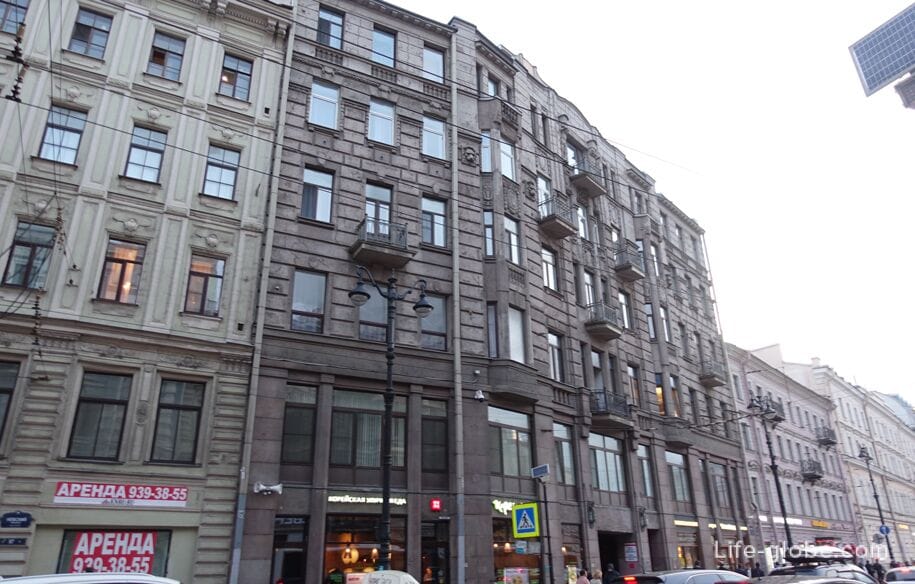
Nevsky Prospekt 97
During the history of the owner of the building often changed.
In 1874-1875, Mikhail Fedorovich Peterson, a railway engineer, built a five-story apartment building. In 1875-1876, two six-story wings and a four-story stone house on Goncharnaya Street were added to the house.
The building has an eclectic style, and its middle part of the facade is distinguished by rectangular risalites and balconies.

Nevsky Prospekt 130
Until the middle of the 19th century, the tar shops of the merchant Afanasy Yemelyanovich Yeremeyev were located on this place.
In the second half of the 19th century, the plot belonged to the merchant of the 2nd guild Grigory Dmitrievich Dmitriev, and since the 1870s-to the merchant Ignatiy Vasilyevich Mikhailov.
Subsequently, the owners of the house changed.
The four-story house and an outbuilding in the courtyard were built in 1874-1875 by the academic architect Karl Karlovich Ziegler von Schafhausen.
The building has an eclectic style. The middle of the symmetrical facade is marked by a powerful bay window of the second and third floors and pairs of balconies of the second and fourth floors to the right and left of the bay window; under the bay window is an arched entrance to the courtyard.
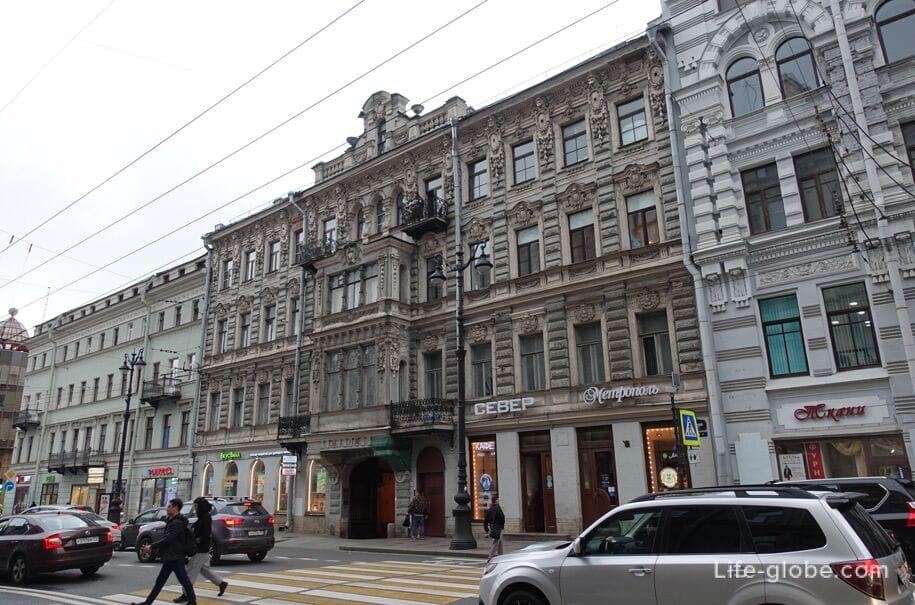
Nevsky Prospekt 132
The house was built in 1877-1881 by the engineer architect Alexander Ivanovich Klimov.
The building has a Neo-Renaissance style and is distinguished by rare semicircular balconies.
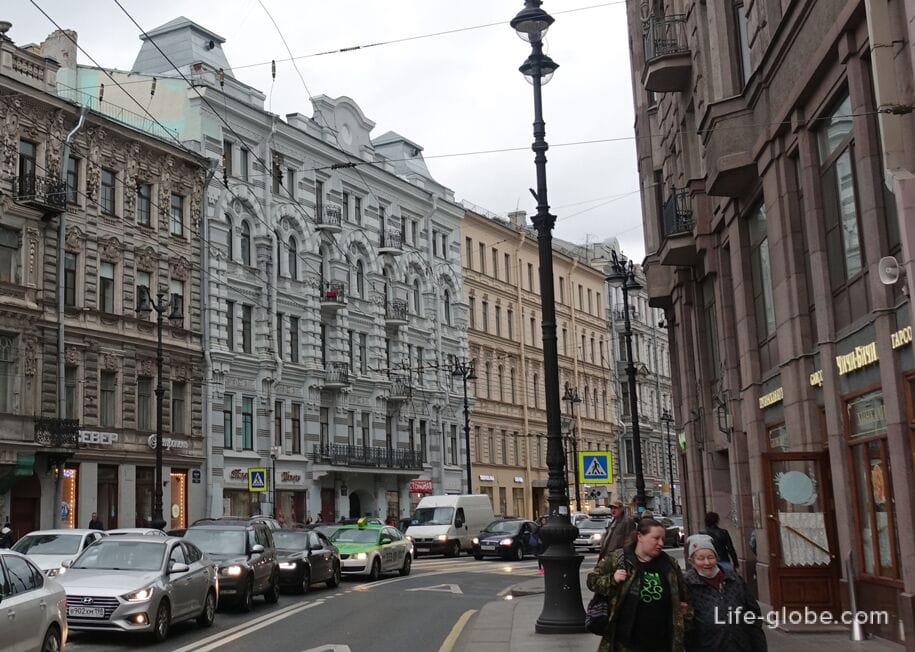
103 Nevsky Prospekt
In the middle of the 19th century, the plot belonged to Klinova, and since 1869-to the merchant Grigory Ivanovich Srednev.
In 1870, the diocesan architect Ivan Yudovich Bulanov built a three-story front house on the site, as well as household and residential buildings. The same architect in 1880 made the reconstruction of the building for a new homeowner-the hereditary honorary citizen Alexey Akakievich Sinyagin.
After the death of A. A. Sinyagin in 1892, his sons Arkady, Vladimir and Nikolai inherited the household and remained its owners until 1909.
In the 1960s, the building was added to the fourth floor.
Now the house is, among other things, one of the mini-hotels "Rinaldi" - Rinaldi Premier, part of the network of St. Petersburg hotels.
The building has an eclectic style. The house is distinguished by a central bay window at the level of the third floor, above which there is a balcony. Two windows of the third floor on each side of the facade are united by decorative triangular pediments and together with the pairs of extreme windows on the second and fourth floors are distinguished by rust ribbons; the windows of the second and third floors are decorated with sandricks.
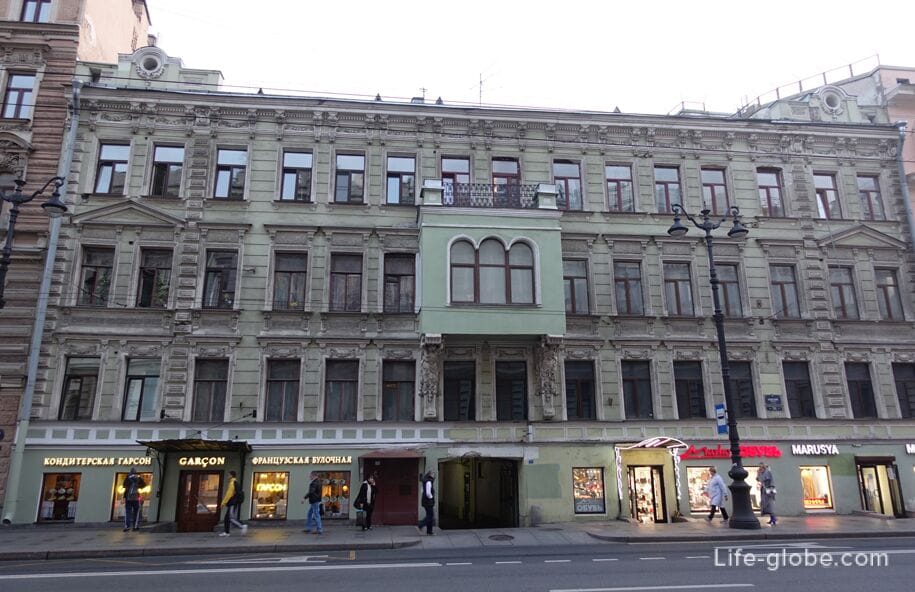
Apartment house of I. S. Gostev (Nevsky Prospekt 105)
Initially, the owners of the site were repeatedly changed.
Since 1880, the plot was owned by the merchant's son Ilya Semenovich Gostev, for whom in 1882 the construction technician Vladimir Akhillesovich Reis built a five-story apartment building.
In 1889, a St. Petersburg merchant of the 1st guild, Konstantin Vasilyevich Chistyakov, acquired the household.
Apartments in the house at the beginning of the 20th century were rented by St. Petersburg merchants and officials, employees of offices and banks, teachers of nearby educational institutions.
According to the bill of sale dated February 3, 1916, the household was acquired by the wife of the St. Petersburg 2nd Guild merchant Agafya Trifonovna Vogel.
The building has an eclectic style and attracts a wide use of rustication combined with elegant cornices and sandricks, and the central part of the facade is highlighted by a powerful bay window; the rich decoration of the third floor is also impressive.
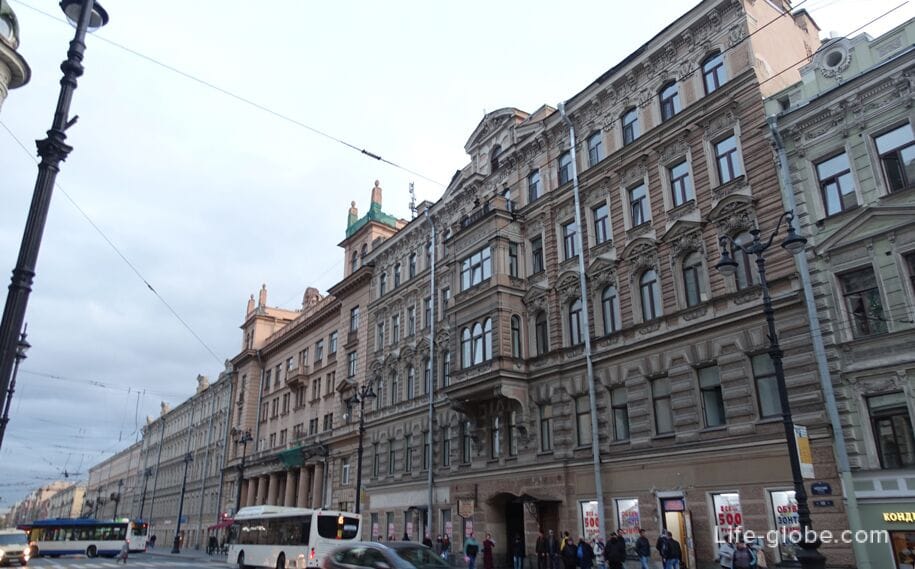
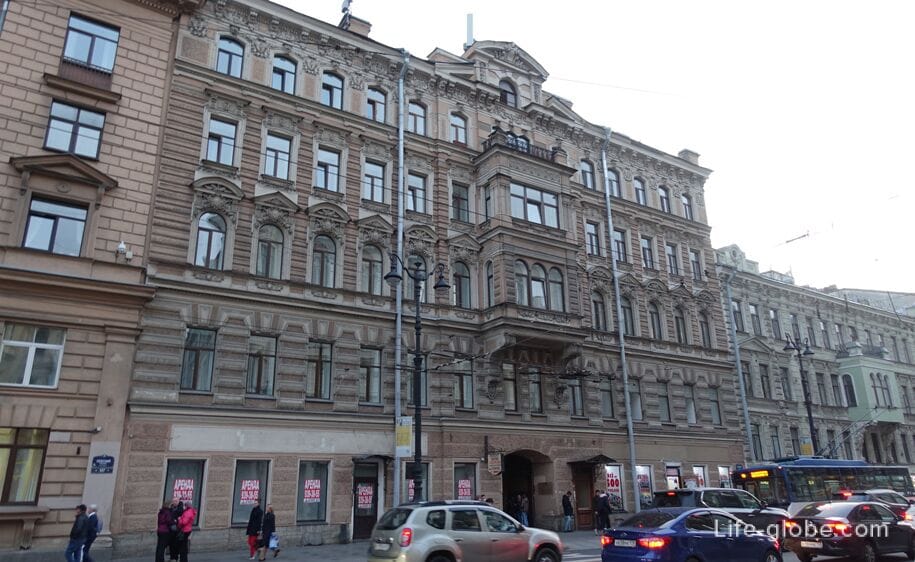
107 Nevsky Prospekt
Since 1865, the site was owned by an honorary citizen, Stefanida Polikarpovna Menshutkina, whose husband, Nikolai Mikhailovich Menshutkin, conducted trade inGostiny Dvor on Nevsky Prospekt. A three-story stone house with a similar wing, a two-story courtyard wing, and one-story stone services were built on the site.
In 1898, an apartment building was built on the site, which has survived almost unchanged to the present day.
In 1952, the architects Viktor Fedorovich Belov and Elena Mikhailovna Lavrovskaya installed obelisks over the risalites of the building (dismantled during the renovation of the house).
It is a large five-story building built in the neoclassical style, with two side risalites and a colonnade between them spanning the two lower floors. The risalits are completed with residential dormers with two windows. The front surface of the risalites is rusticated. The central axis of the facade is highlighted by a balcony and a gable roof.
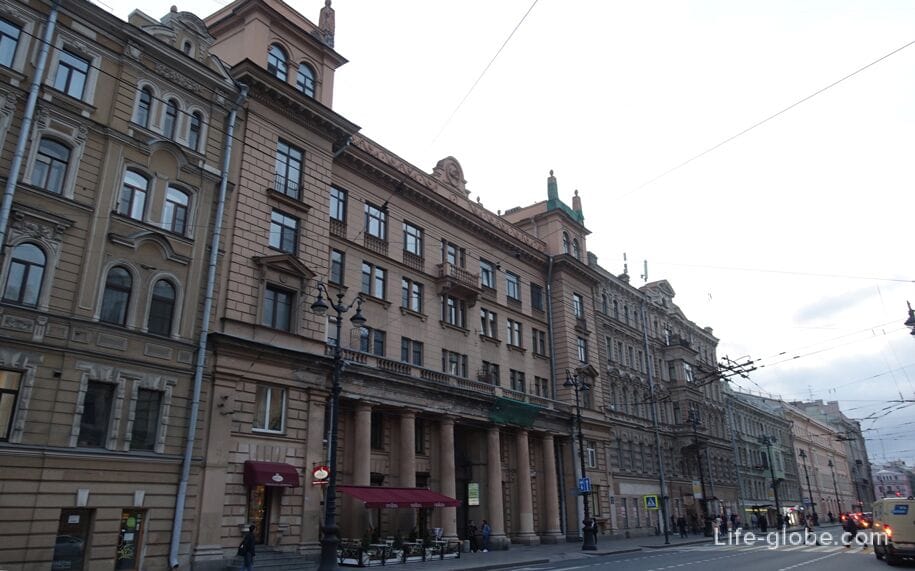
109 Nevsky Prospekt
In the middle of the 19th century, the undeveloped plot belonged to Major Vladimir Andreevich Kossikovsky, then to merchant Alexander Semyonovich and hereditary honorary citizen Dmitry Alexandrovich Dmitriev.
In May 1875, the household of D.A. Dmitriev consisted of an iron-roofed front stone three-story house on a granite plinth, a detached stone one-story house and a one-story stone wing.
On February 27, 1878, part of the household passed to the merchant of the 2nd guild, Alexander Vasilyevich Kapralov.
After his death in November 1895, D.A. Dmitriev was succeeded by his son Nikolai.
The apartment house of the merchant A.V. Kapralov was rebuilt in 1878-1879 by the architectural engineer Vasily Mikhailovich Nekora, who settled in the house, occupying 10 rooms, two front rooms and a kitchen on the second floor, a barn and a stable, paying the landlord 2000 rubles a year.
The five-story house has an extended facade, decorated in an eclectic architectural style. The facade of the building is distinguished by the decor and gables. The various forms of window openings are striking - from rectangular on the first, second and fifth floors to semicircular on the third; they are decorated with cornices and sandricks. The first floor, decorated with rust, is occupied by commercial premises.
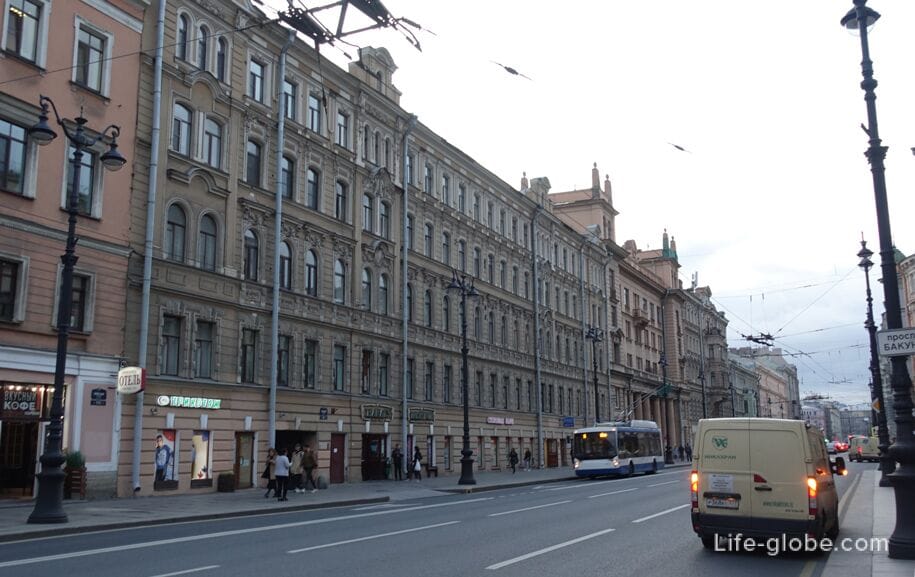
Apartment house of A. K. Savin (Nevsky Prospekt 140)
In 1890-1907, the plot belonged to the hereditary honorary citizen Andrey Kirillovich Savin and his wife Evdokia Timofeevna. On the plot there were: a stone two-story residential building, one-story stone and wooden outbuildings and shops.
in 1901-1902, the architect Alexander Sergeyevich Khrenov built a five-story apartment building and three-story stone wings along the rear border of the courtyard, and he also gave the corner part of the building (Nevsky Prospekt and Degtyarnaya Street) a characteristic appearance for his work with a round bay window completed with a decorative tower.
The premises of the first floor of the building were intended and are intended for retail premises and are equipped with rectangular display windows; the semicircular windows of the third floor are decorated with an ornamental cornice-belt.
The architectural style of the building is eclectic.

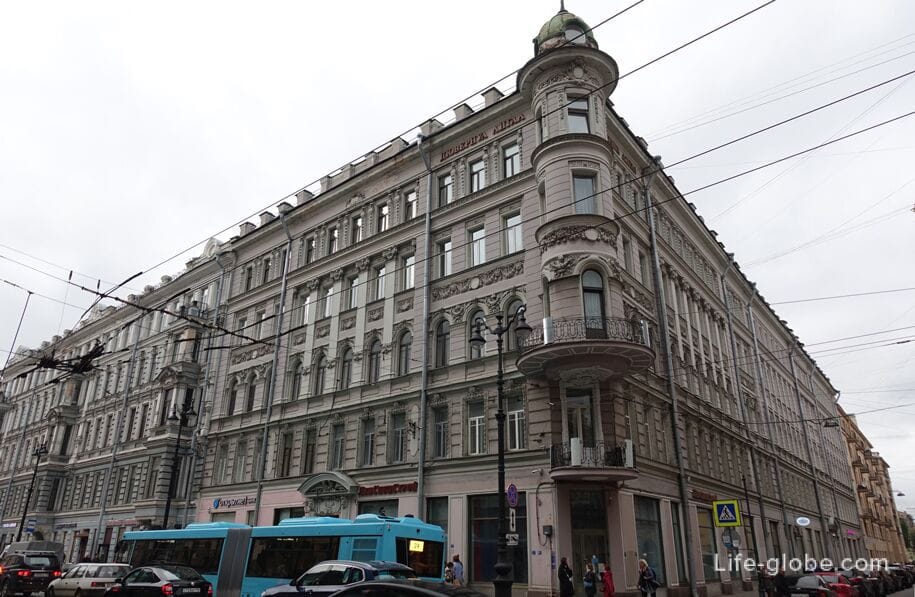
Apartment house of I.V. Galunov (Nevsky Prospekt 142)
The house was built in 1877-1880 by the architect Alexander Vasilyevich Ivanov.
In 1900, the building was expanded by D.A. Kryzhanovsky.
The house has an eclectic style and the rounded facade of the building faces Nevsky Prospekt. Also attention is drawn to the massive bay windows and the abundance of decor on the facades.
Today, the building houses, amongothers: the 4-star Galunov Hotel with free Wi-Fi, free private parking, a 24-hour front desk and breakfast included in the room rate; the 3-star FILIPPOV rooms Hotel with a 24-hour front desk, a shared kitchen, free Wi-Fi and private parking.
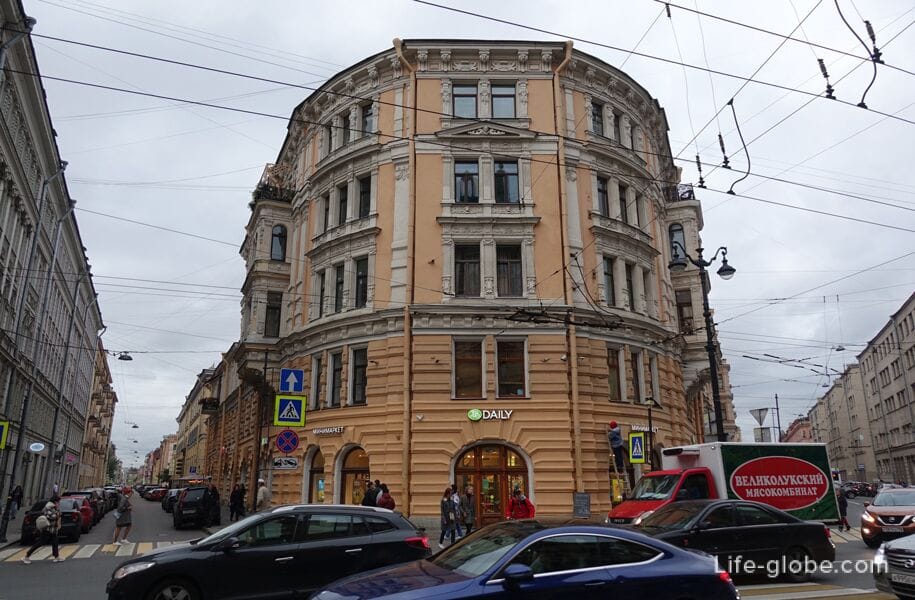
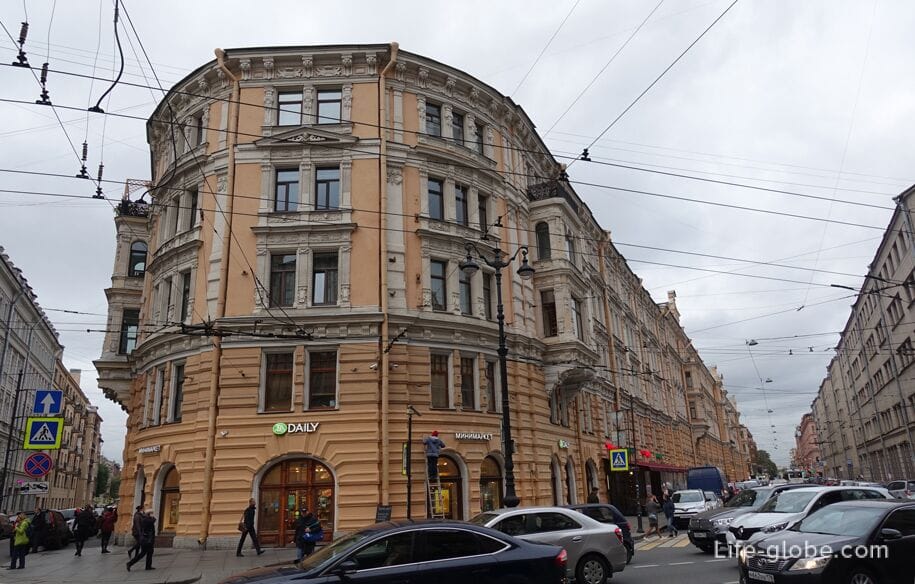
Nevsky Prospekt 148 and 150
In the middle of the 19th century, the entire side of the Nevsky from Military Street (originally Glukhoy Street, from 1858 to the present - Poltava Street) and to the Lavra was occupied by shopping malls of the Old Alexander Market.
By148 Nevsky Prospekt is an interesting building, the first three floors of which have decorative finishes, and the top two are superstructured and have no external decorations.
The building at number 150 was built in 1880 by the architect Fyodor Fedorovich Solovyov. Then the house was profitable and later added on.
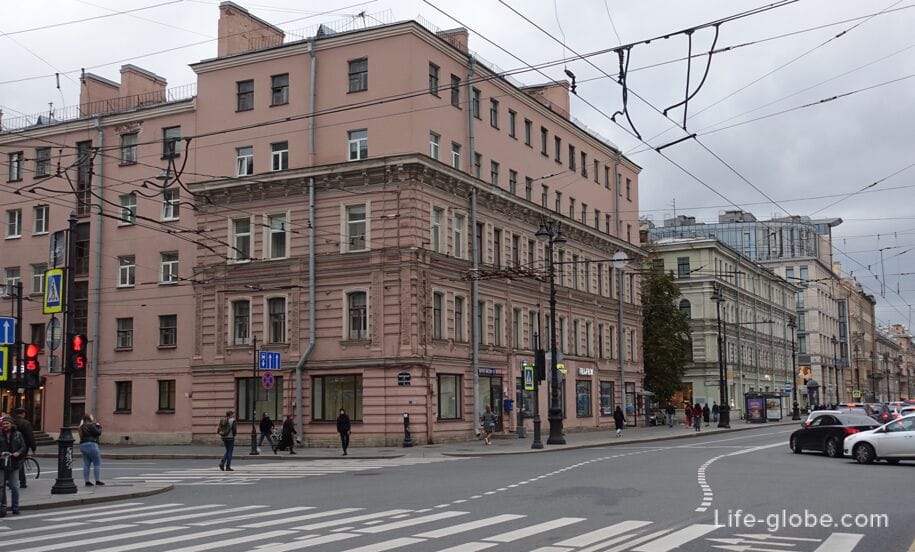
Between the houses 148 and 150 there is a pedestrian zone-Solovyov-Sedogo Square.
Behind the house at number 150 from Nevsky Prospekt and to Konnaya Street runsBogie Lane, which is a fully pedestrian area with seating areas and lawns.
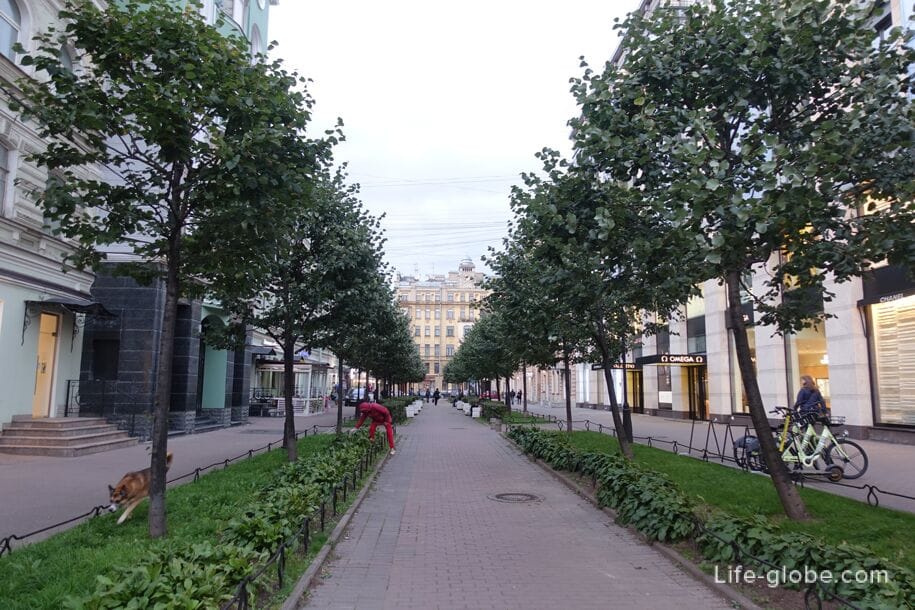
Ryzhovs ' Apartment house (113 Nevsky Prospekt)
The Ryzhovs ' apartment house, also known as the I. E. Garunov Apartment house, was built in 1872, presumably by the architect A. S. Kirillov. The Ryzhovs owned the house until 1911.
Since 1916, the building was owned by the merchant of the 1st guild Harunov Ivan Evgenievich.
The building has a modest facade decor.

Residential building "Le Grand" (152 Nevsky Prospekt)
This modern building was built in 2008 by the architects of the workshop "Evgeny Gerasimov and partners" on the site of the square. This is an eight-storey residential building "La Grande" with an underground parking lot, the first floor of which is occupied by commercial premises.
A special feature of the architectural solution of the building was the combination of two different volumes in shape and material: rectangular (a six-story stone parallelepiped supporting the height of the existing building) and elliptical (a glass two-story attic with an offset from the plane of the facade wall of the main part of the building).
A distinctive feature of the layout of the building is the internal glazed residential courtyards with terraces on the roof of the shops on the 2nd floor. The staircase and elevator nodes are located along the blind firewall of the neighboring house (No. 154), connected to the residential halls by glazed passages that form the courtyards.
The facade is lined with "Jurassic marble" - Bavarian limestone of a warm shade. The middle tier is decorated with rusticated stone pilasters forming window niches with decorative lattices of French balconies.
The building is completed with two oval glazed floors, which offer a panoramic view of the city center.

Nevsky Prospekt 154 and 156
Nevsky Prospekt 154-Pirogov apartment building, which was built in 1898 by the architect Alexander Vasilyevich Ivanov for the engineer-technologist of the owner of the brick factory Ivan Ivanovich Pirogov.
In 1904, Antonina Alekseyevna Pirogova inherited the house and owned it until 1917.
The kindergarten "Children's Hearth" operated in the building during the entire blockade.
The five-story building is designed in the eclectic style. The central part of the absolutely symmetrical facade of the house is highlighted by the entrance to the courtyard and the main entrance to the right of it; to restore symmetry, a false front door is arranged to the left of the entrance arch. The arch and the front rooms are united by a 2nd-floor balcony with a rectangular bay window in the center. The semicircular windows of the second floor are decorated with sandricks. On the ground floor there are retail premises with large rectangular windows-showcases.
Nevsky Prospekt 156-apartment house Parfenov, which was built in 1910-1912 by the architect Gustav Gustavovich von Goli as one of the apartment houses of merchants Dmitry and Fyodor Lavrentievich Parfenov, whose heirs by 1917 owned ten houses in different parts of the city.
The six-story building is designed in the neoclassical style, and, in contrast to the two surrounding buildings, it looks calm and strict. The facade is decorated with ceramic tiles, gray relief stone of the first two floors and the extreme verticals of the third and sixth floors. On the extreme verticals at the level of the third floor there are balconies. The first floor is distinguished by an arch and large windows-shop windows.
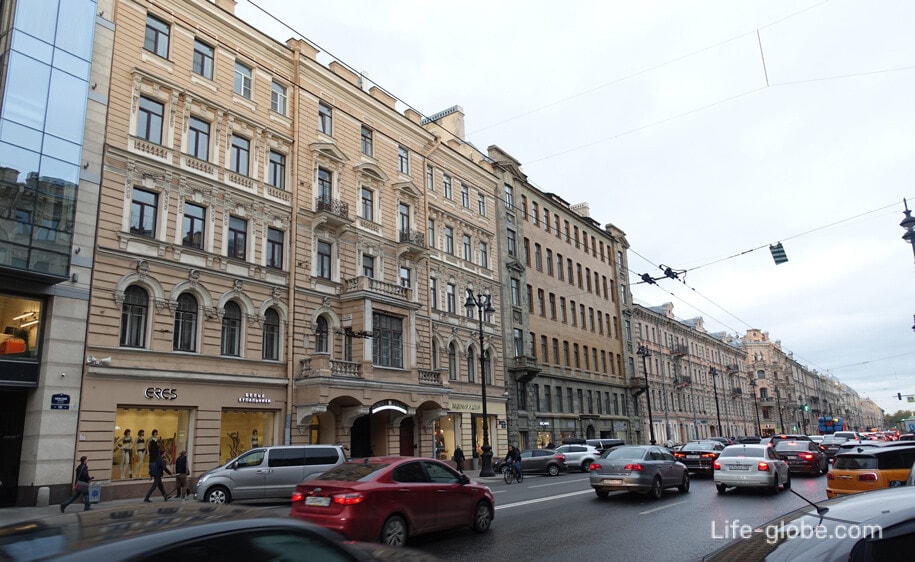
158 Nevsky Prospekt
The building was built in 1874 by the diocesan architect of the Alexander Nevsky Lavra, Ivan Bulanov.
In 1895, the house belonged to a large landlord who kept a bakery and small trade in the building, and a renskovyj cellar - merchant Ivan Ivanovich Kokin, who owned the building among several houses until 1917.
The four-story corner building is designed in an eclectic style. The extended facades of the house are decorated with modest cornices; the facade facing Nevsky Prospekt has balconies on the third and fourth floors; the corner of the house is sloped and there are two balconies on it.
On the ground floor there are commercial premises.
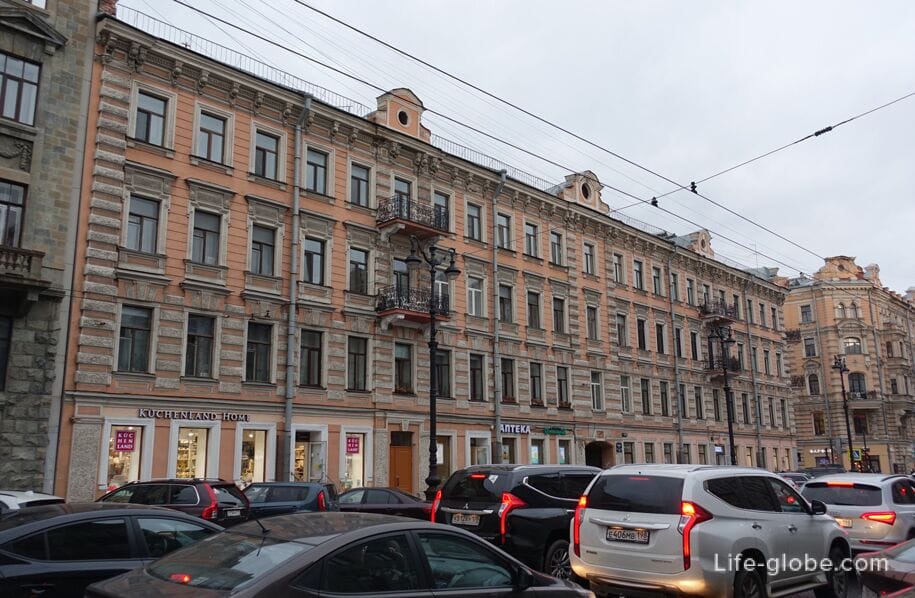
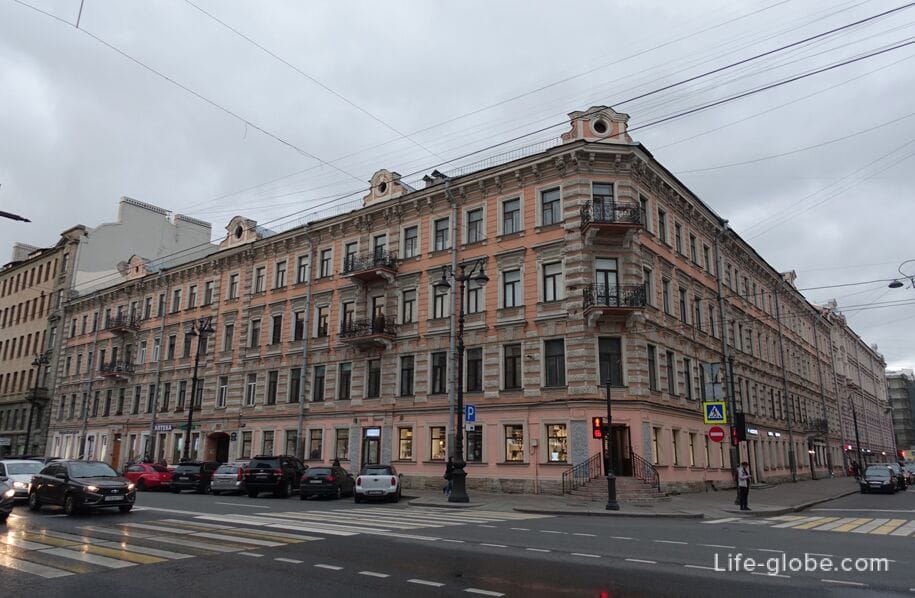
Nevsky Prospekt 160 and 162
Nevsky Prospekt 160-the apartment house of D. L. and F. L. Parfenov was built in 1878-1880 by the architect Grigory Alexandrovich Solovyov, for merchants Dmitry and Fyodor Lavrentievich Parfenov, who made their capital in the sausage trade.
With the construction of this house, the Parthenovs began investing in real estate. After the construction was completed, the house was sold to Ivan Evstafyevich Ivanov, a member of the charity society of the Borisoglebskaya Church, the owner of the material yards.
The five-story corner building is designed in an eclectic style. The facades are decorated with rusticated rectangular three-window bay windows (two on the facade facing Nevsky Prospekt and one on the facade of Perekupny Lane), covering the 3rd and 4th floors. The axes of the bay windows are completed with pediments of complex shape, and the windows between them are finished with sandricks and cornices. The corner of the house is sloped and also completed with a pediment of complex shape and on the corner facade there is a wide balcony of the 3rd floor, supported by caryatids. The lower windows in the corner facade are widened, and the narrow windows of the fifth floor are doubled.
Nevsky Prospekt 162-an apartment building on this site was built in 1874 by academician architect Mikhail Arefyevich Shchurupov, who in 1888 occupied six rooms in this house with a front room and a kitchen. At that time, it was a four-story stone house with similar wings on the side borders of the courtyard.
In 1888, the household belonged to the merchant of the 1st guild, the hereditary honorary citizen Isaac Vasilyevich Konstantinov, who occupied two apartments in the front house on the first floor (14 rooms), a coachman's room, a stable, a barn and a cowshed in the yard.
In 1890, Isaac Vasilyevich could not pay the interest on the loan to the St. Petersburg Credit Society, and in 1893 he stopped insuring real estate, after which the household, in June 1893, was acquired by the hereditary honorary citizen Alexander Fedorovich Korovin, who six months later sold it to the Yaroslavl peasant Fyodor Artemyevich Ponomarev, who owned the plot until his death in 1903, after which the household was inherited by his widow Evlampia Ivanovna, who owned the house until 1917.
In 1898-1899, the technician Pavel Mikhailovich Mulkhanov rebuilt the front house into a five-story one.
The five-story building is decorated very modestly. On the third floor, the window sill is decorated with balusters, and the windows on the 4th floor are decorated with sandricks. The first floor of the house, as it was today accepted on Nevsky Prospekt, is reserved for retail premises.
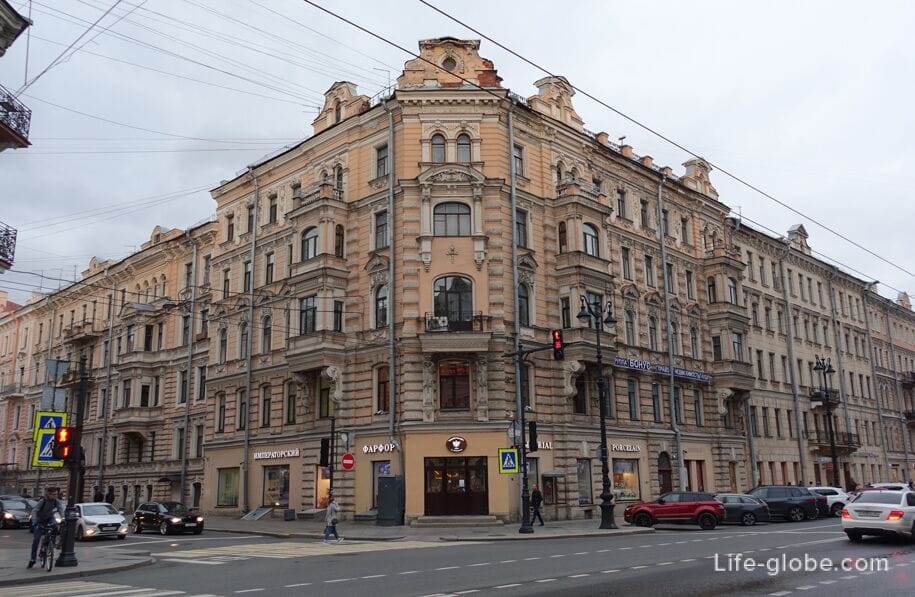
Nevsky Prospekt 164
The profitable stone house with the same wings was built in 1880-1881 by the technician Mikhail Andreevich Andreev for the temporary St. Petersburg merchant of the 2nd guild T. S. Badaev.
In order to cover his debt to the St. Petersburg Credit Society, Badaev put the house up for auction, and in September 1875 the house was acquired by the wife of the Kholmogorsky merchant Alexandra Vasilyevna Tomilina (in the second marriage of Evstafiev), who owned the building until 1917.
The building is designed in an eclectic style. Rustication is used in the facade decoration, and the semicircular windows of the third floor are distinguished by a stucco belt-cornice. Stucco cornices of a simple pattern divide the facade between the second, third and fourth floors. The facade decor is completed by a stucco cornice with pairs of balconies above the windows of the fifth floor.
The first floor of the house is adapted for retail premises with separate entrances.
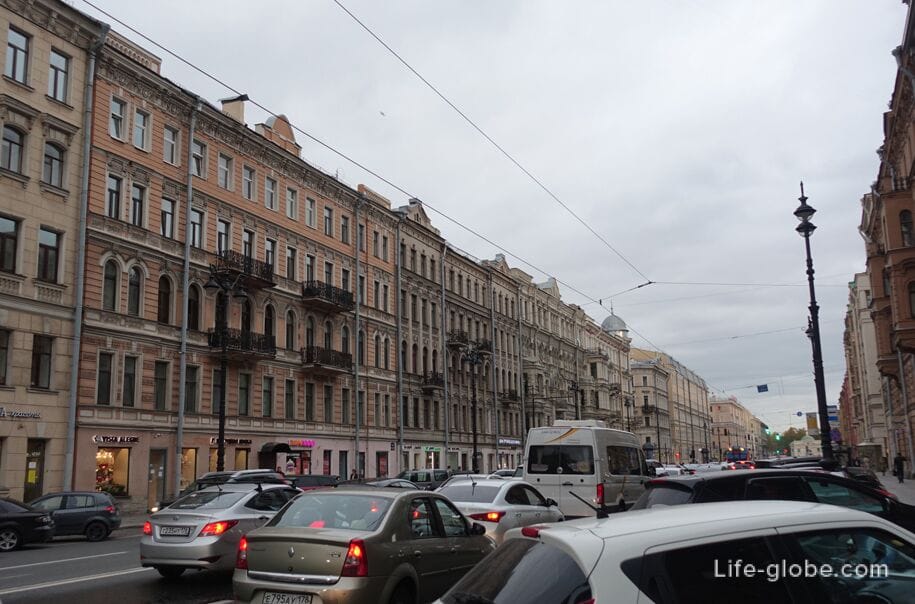
166 and 168 Nevsky Prospekt
Nevsky Prospekt 166-a five-story apartment building with the same wings on the boundaries of the site was built in 1880-1882 by the engineer-architect Alexander Alexandrovich Dokushevsky for the merchant's son Pantelei Trifonovich Badaev.
In 1905, the separate households of Badaev, which had a common yard, were united, and in 1917, the widow of P. T. Badaev - Anna Vasilyevna, who owned the house until 1919, became the homeowner.
On the symmetrical facade of the building, the central part with richly decorated semicircular windows of the third and balconies of the third and fourth floors stands out with its decor. Above the fifth floor there are decorative gables. The first floor is highlighted by large storefronts and is occupied by commercial premises.
Nevsky Prospekt 168-apartment house of A. A. Nikolaev, which was built in 1880 by the engineer-architect Klimov Alexander Ivanovich for the merchant Alexander Andreevich Nikolaev, to whom the house belonged until 1917.
In 1898-1899, the academic architect Vladimir Rodionovich Kurzanov built the house and combined it with the house he built on Konnaya Street, 19.
The five-story building is designed in the neo-Russian style with a richly decorated facade in the style of late eclecticism.

Apartment house of V. M. Davydov (Nevsky Prospekt 170)
The house was built on the site of the former buildings in 1897-1898 by the academic architect Pavel Yulyevich Suzor for the merchant of the 1st guild of the brick breeder Ivan Pavlovich Porshnev and the grain merchant Wulf Mordukhovich Davidov.
After Porshnev's death in 1907, he became the sole owner of the building and settled in the House of Davids.
The five-story building is angular, designed in the eclectic style. It is distinguished by a rounded corner with a domed roof; it also has balconies, bay windows and facade decorations.
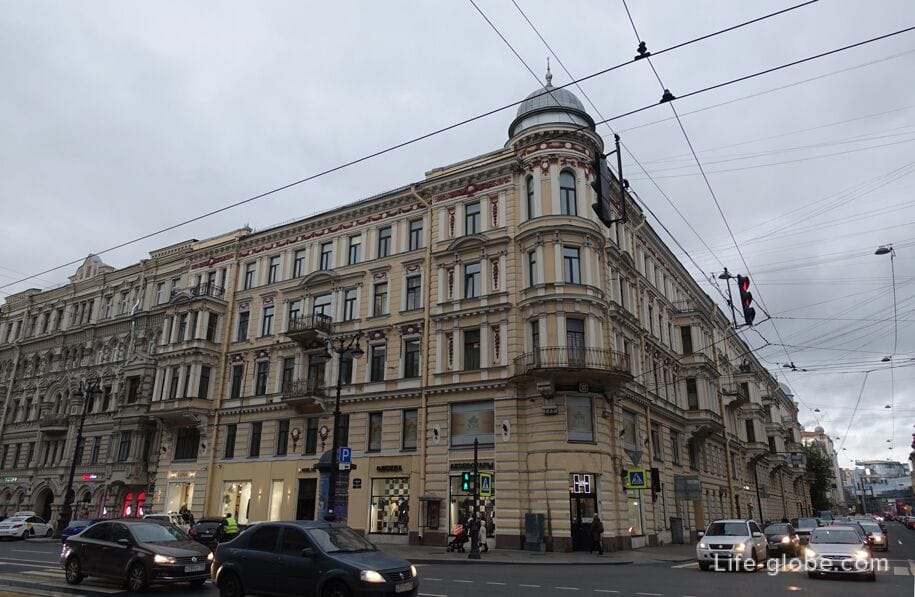

Nevsky Prospekt 115, 117 and 119
Nevsky Prospekt 115 is an apartment building built in 1860-1861 by the architect Fyodor Matveevich Tutyshkin for the Tsarskoye Selo merchant of the 2nd Guild Fyodor Petrovich Petrov.
Since the late 1990s, the building has been completely renovated.
Nevsky Prospekt 117 - the house of A.L. Kekin or the house of the Rostov Yaroslavl province city society.
The building was built in 1860 by the engineer-architect Yevgeny Yevgrafovich Anikin. In 2008, an attic was added.
One of the owners of the house was a merchant Alexey Leontievich Kekin. According to Kekin's will, the house passed to the Rostov city society for the construction of a gymnasium and a university.
Nevsky Prospekt 119-the house was built in 1900-1901 by the architect Gilev Pyotr Ivanovich.
The five-storey building is designed in the eclectic style, stands out for its massive and heavy appearance, as well as facade decorations and side bay windows on the 3rd and 4th floors.
In the photo of the house from left to right: 119, 117, 115
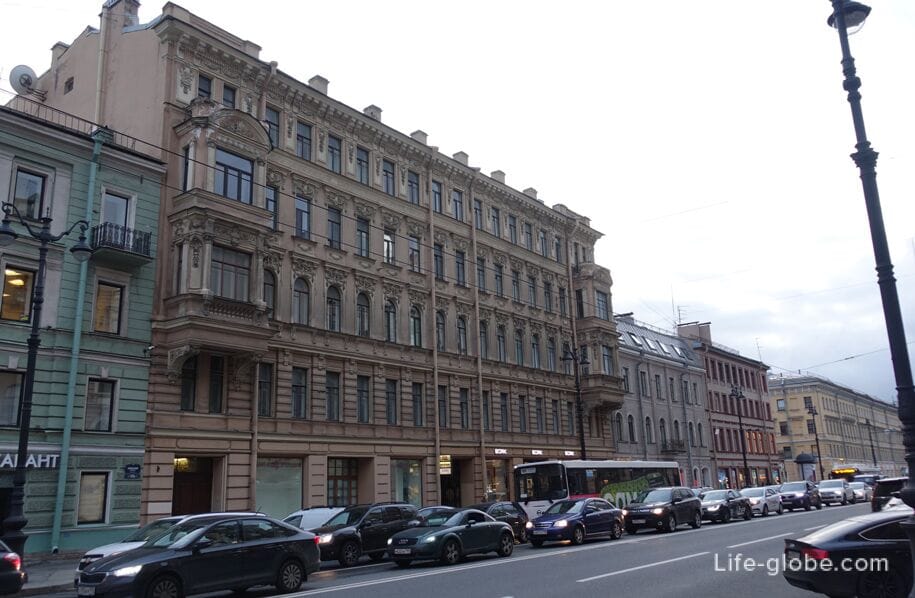
123 and 125 Nevsky Prospekt
Plot by123 Nevsky Prospekt from the end of the 1870s belonged to the merchant of the 2nd guild I. M. Gorbunov. In 1881-1882, Academician of Architecture M. A. Shchurupov built a four-story residential building on the site.
In 1916, the owners of the house were the heirs of the peasant V. I. Levshin, who bought the house for his children in 1909.
Plot bySince the beginning of 1869, Nevsky Prospekt 125 belonged to the merchant M. A. Semenov, who kept a hotel on the first floor of a three-story stone house built in 1859-1861 by the technician-caretaker E. P. Dmitrevsky.
In 1878, the peasant V. I. Levshin purchased the house. In 1881, the architect A. I. Klimov built three-story wings on the site.
After the death of V. I. Levshin in 1908, his heirs owned the house until 1917 inclusive.
Both buildings look inconspicuous, have few details of decoration on the facades and are architecturally similar.

127 and 129 Nevsky Prospekt
127 Nevsky Prospekt-a four-story apartment building on the site of the previous buildings was built in 1904 by the architectural engineer E. P. Decleron.
The building has a commercial ground floor with large windows-showcases and with an arch shifted to the right border-the entrance to the courtyard, which is decorated with rust. The middle of the smooth facade of the building is highlighted by the balconies of the second and third floors, the entrances/exits to which are decorated with sandricks in the form of pediments. Triangular pediments-sandricks adorn the windows of the third floor, adjacent to the balcony door; and rectangular pediments-sandricks adorn the windows located through one window from the balcony door of the second floor.
Nevsky Prospekt 129-N. T. Sokolov's apartment building, which was built in 1880-1881 on the site of the former wooden buildings by the construction technician Vladimir Akhillesovich Reis for the merchant of the 2nd guild Nikolai Timofeevich Sokolov.
This five-story house differs from the neighboring buildings both in height and in the richness of the facade decoration characteristic of the eclectic architecture of that period of transition to Art Nouveau, on which a powerful two-story bay window with double front windows stands out.
The facade with sculptural and stucco decorations is partially plastered. The semicircular windows of the two upper floors of the house stand out; the windows of the fourth floor are decorated with deep sandricks. On the ground floor there are retail premises with large windows-showcases.
In the photo of the house from left to right: 129, 127
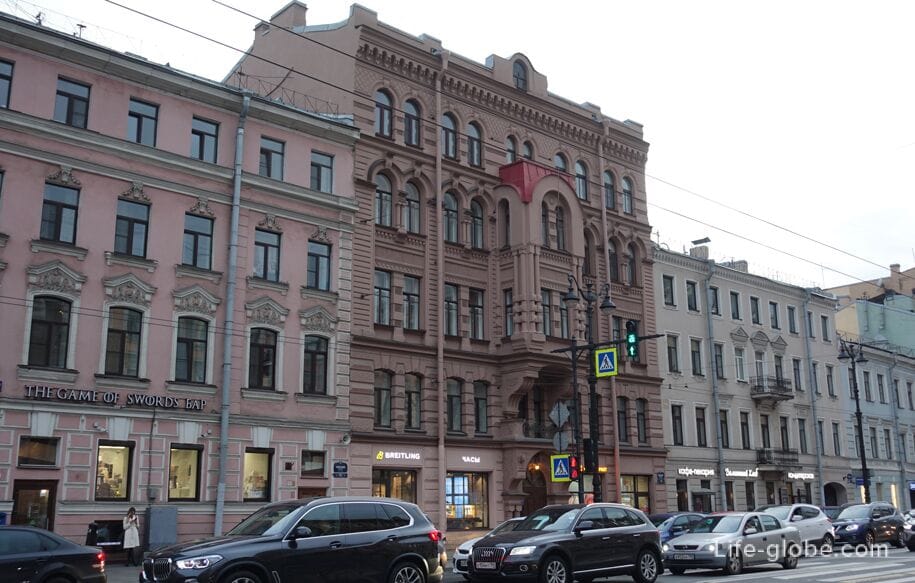
131 Nevsky Prospekt
The house was built in 1867 by the architect Buleri Ludwig Fedorovich (Edmundovich). Later it was built on.
The four-story building is designed in an eclectic style. It is distinguished by the decoration of the window openings of three floors and has an arched passage in the left corner of the building. The first floor is given over to commercial premises and has large windows.
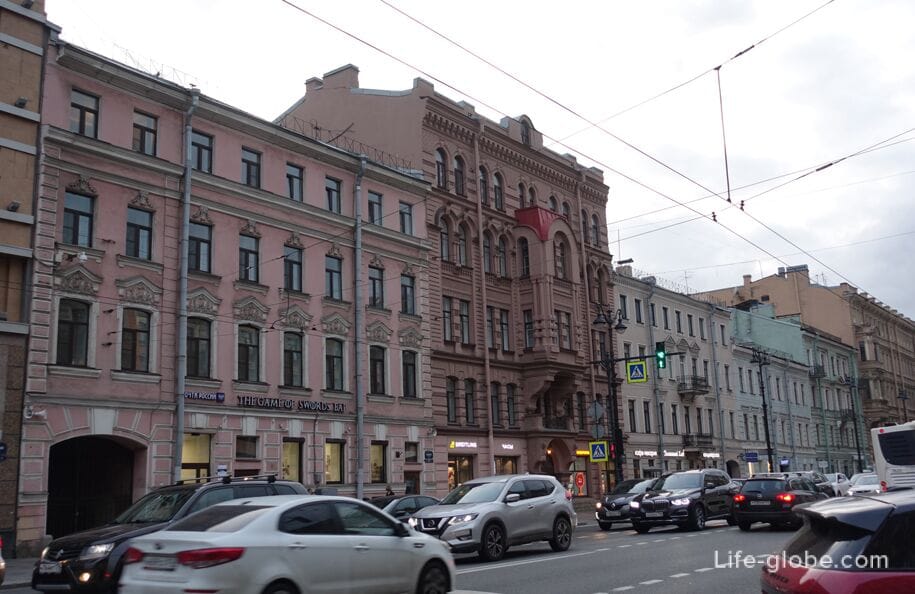
Nevsky Prospekt 133-137 and 139
Nevsky Prospekt 133-137 is a large seven-storey residential building.
This modern house with retail and office space on the lower floors was built in 2001-2002 by the architectural studio "Evgeny Gerasimov and Partners" and designed in the style of the transformed avant-garde. The three-part three-dimensional solution of a residential building is constructed as an ensemble of two symmetrically arranged parts of the building with galleries, two front arches, united from above by the" plate " of the penthouse and compositionally (and functionally) connected by a staircase and elevator node. The staircase and elevator node with glazed galleries is the central compositional axis of the building's symmetry and marks the main entrance from Nevsky Prospekt. Two front arches break the characteristic front of the ordinary building.
Before the war, this place was occupied by houses No. 133 (architect A.A. Zatsky, 1896) and No. 135 (architect F.P. Fedorov, 1914). During the war, the buildings were destroyed.
Nevsky Prospekt 139-the house was built in 1879-1880 by the architect Goldberg Eduard Vasilyevich for the merchant I.V. Epishkin.
In 1881, the building was bought by the commercial adviser N.I. Rusanov; later - the insurance company "Russia", which rented out rooms to workers who had a steady income.
The five-story building is designed in the eclectic style. It is distinguished by a strict color scheme with an architectural classic, for part of the buildings on Nevsky Prospekt, finishing and massive bay windows on the third and fourth floors. At the level of the 5th floor, the bay windows are completed with balconies.
In the photo of the house from left to right: 139, 137-133
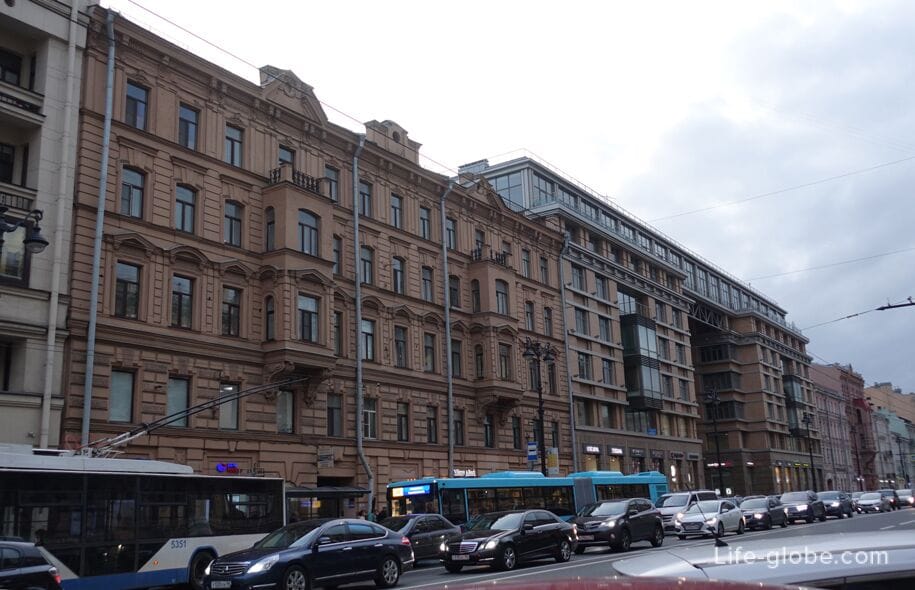
141 Nevsky Prospekt
The residential building in the style of Stalinist neoclassicism with elements of constructivism was built in 1936 by the architect Alexander Lvovich Lishnevsky.
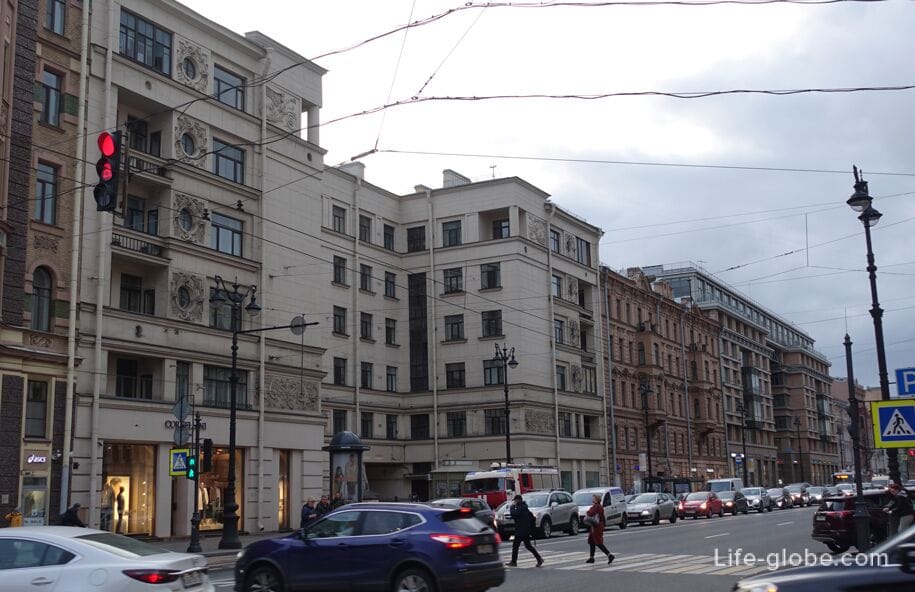
Apartment house of I.I. Kruglov (147 Nevsky Prospekt)
The I. I. Kruglov apartment house in the Art Nouveau style, on the corner of Nevsky Prospekt and Professor Ivashentsov Street (No. 1), was built in 1905 according to the project of the civil engineer Pyotr Nikolaevich Batuev.
The house is designed in the Art Nouveau style, and its corner is rounded.
In the left front door (entrance) on the windows of the stairwells there are remnants of stained glass Windows.
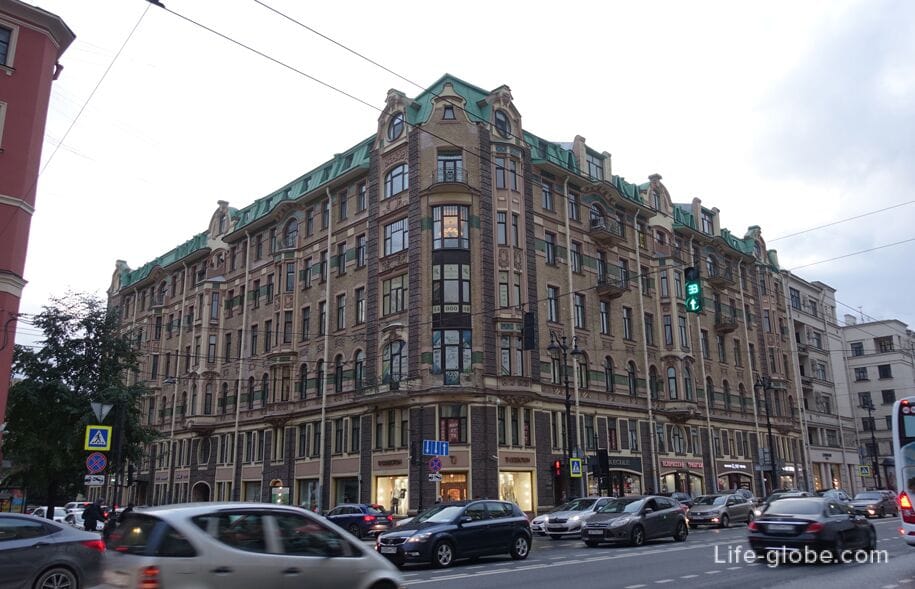
Nevsky Prospekt 172 and 174
Nevsky Prospekt 172-originally on the site there was a corner stone three-story house with a mezzanine, which during the history belonged to different owners.
In 1875, the architect Hofer Jacob Karlovich completed the expansion and superstructure of the building.
In 1879, the architect Nekora Vasily Mikhailovich rebuilt the building into a five-story building.
The corner of the house is cut off and decorated with a balcony, on the ground floor there are commercial premises with large windows-showcases.
The building is connected by a monumental arch to the building on the174 Nevsky Prospekt - Alexander Nevsky House of charity for the poor of the clergy (departments of the administration of the Central District).
The four-story building was laid out in 1863. Construction was completed in 1869. The building was designed by architect Grigory Ivanovich Karpov.
Since 2009, the MFC of the Central District and the administration departments have been located in the house. There is also a restaurant in the building.
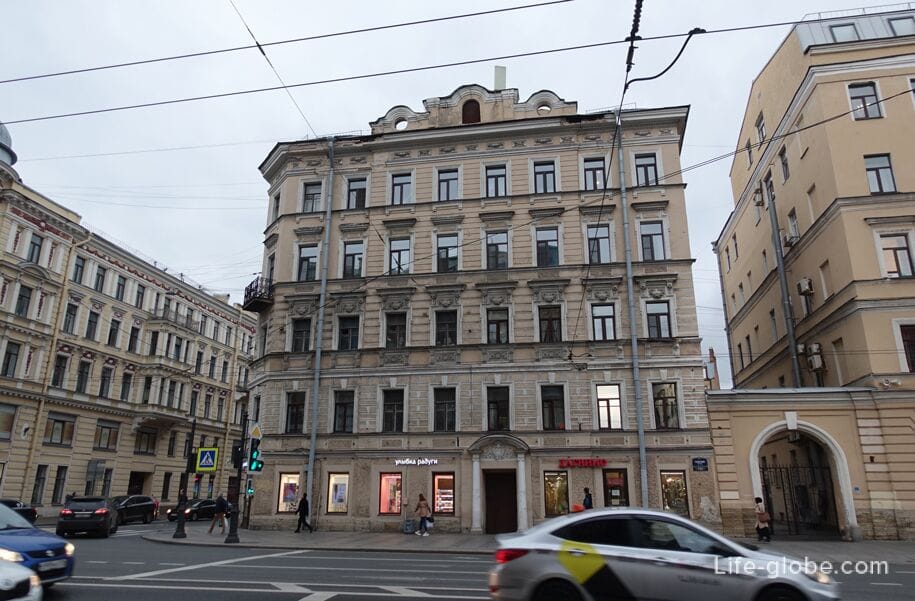
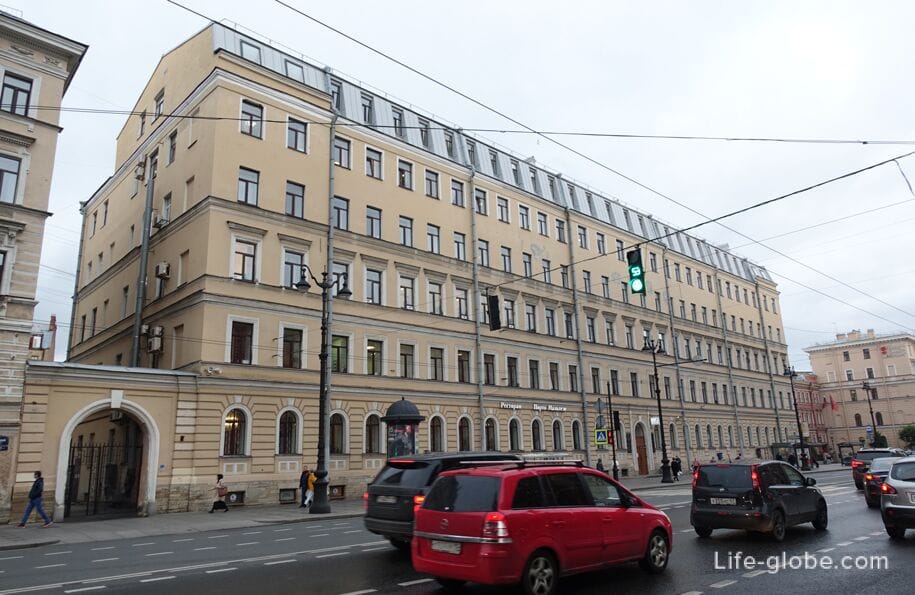
176 Nevsky Prospekt
The building is known as the Isidorov Diocesan School-Smolninsky District Council - Administration of the Central District-Business Center.
The building was built in 1885-1886 by architects Grigory Ivanovich Karpov and Vladimir Fedorovich Kharlamov.
In 1899-1890, the architect Alexander Khrenov made an expansion of the building.
In 1913, a new courtyard building was built.
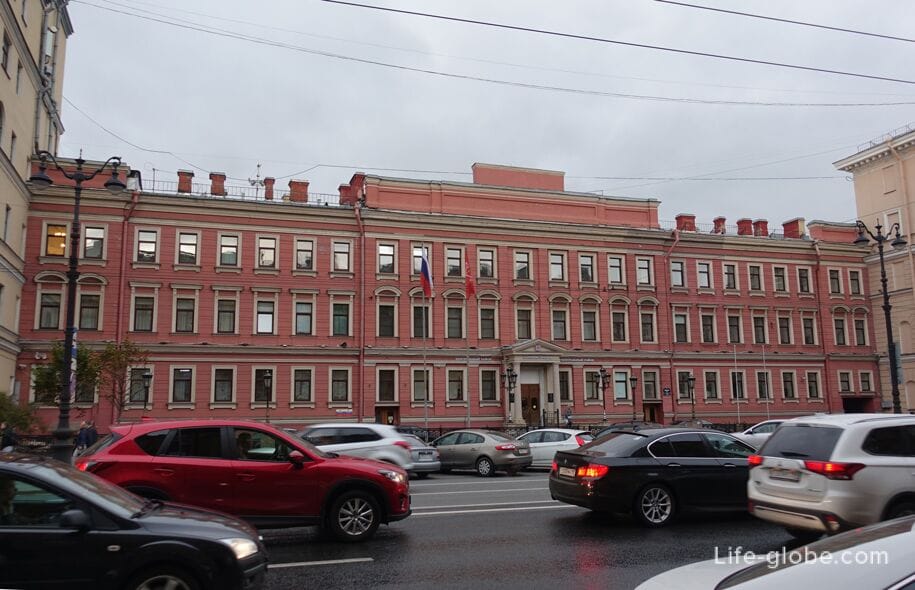
Nevsky Prospekt 178
The house is known as the building of the Spiritual Consistory-Residential building-Volodarsky District Council of Workers ' Deputies-Volodarsky district Committee of the CPSU (b) - Bank.
The building was built in 1845 by the architect Brandt Karl Ivanovich. In 1932, the superstructure and rebuilding were completed.
The five-story building is designed in the style of Stalinist classicism.
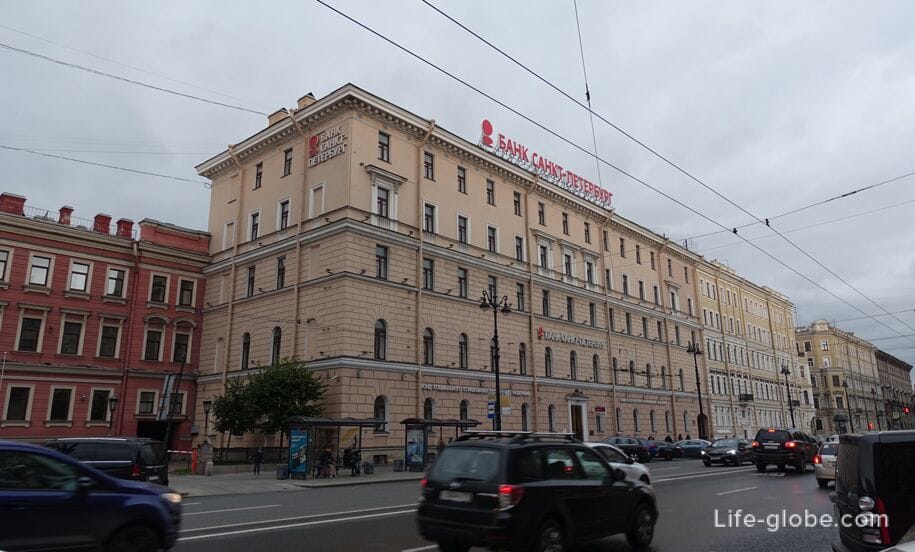
Apartment buildings of the Alexander Nevsky Lavra (Nevsky Prospekt 180, 182 and 184)
Two corner houses on Nevsky Prospekt 180 and 182 are made in the eclectic style and are known as the apartment houses of the Alexander Nevsky Lavra, since previously the plots belonged to the Alexander Nevsky Lavra and wooden houses of the clergy of the Church of Our Lady of All Sorrows of Joy were built on them.
The original three-storey buildings of the same type were built in the second half of the 19th century by the architect Grigory Ivanovich Karpov.
During the reconstruction after the Great Patriotic War, the houses were built up to five floors. On the sloped corners of the houses, rectangular bay windows (2nd and 3rd floor) are arranged, supported by decorative brackets-sandric windows of the 1st floor.
Photo of the house 180
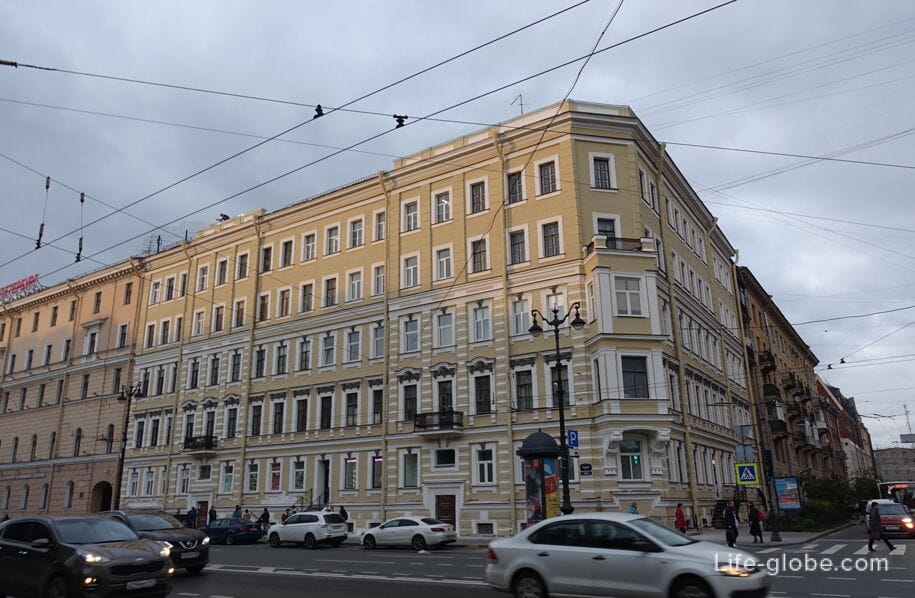
The house No. 182 is adjacent to the residential building on 184 Nevsky Prospekt, which was built in 1955 by the architect A.V. Vasiliev, on the site where previously there were apartment buildings that belonged to the Alexander Nevsky Lavra.
On October 9, 2018, a memorial plaque was unveiled (installed on the house) to the captain of long-distance navigation, Hero of Socialist Labor Aram Mikhailovich Oganov. The text of the board reads: "In this house from 1973 to 2008 lived a long-distance captain, Hero of Socialist Labor Aram Mikhailovich Oganov."
The building is designed in the style of Stalinist classicism.
Photo of house 182, behind which house 184 is visible
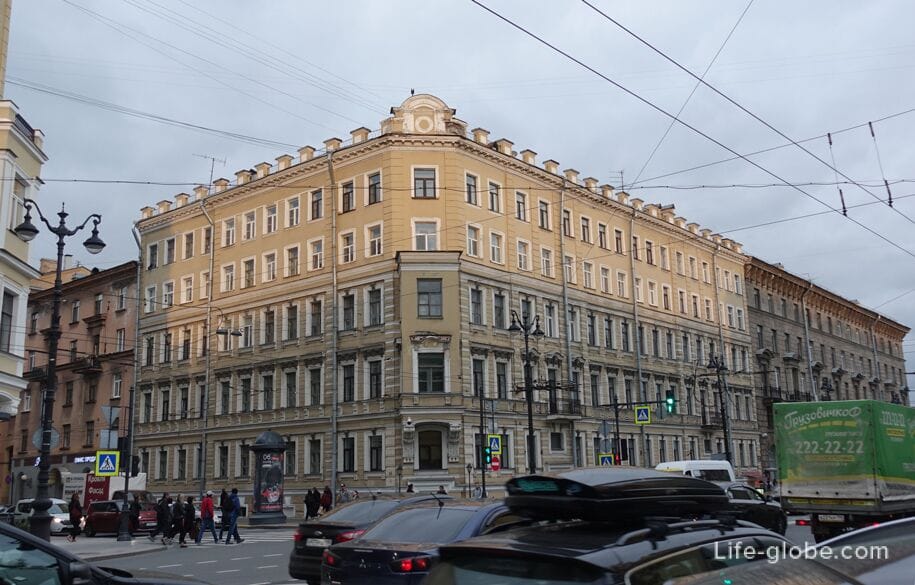
151 Nevsky Prospekt
The building at 151 Nevsky Prospekt is known as the apartment building of the Alexander Nevsky Lavra-a residential building.
The house was built as a profitable one in 1895, when the land belonged to the Alexander Nevsky Lavra. The architect is unknown. Before the revolution, teachers and staff of the Theological Academy and seminary lived in the house.
The house was 3-storey; the fourth and fifth floors were added in 1939, these floors can only be accessed from the courtyard. In 2010, apartments on the first three floors were bought from residents for offices.
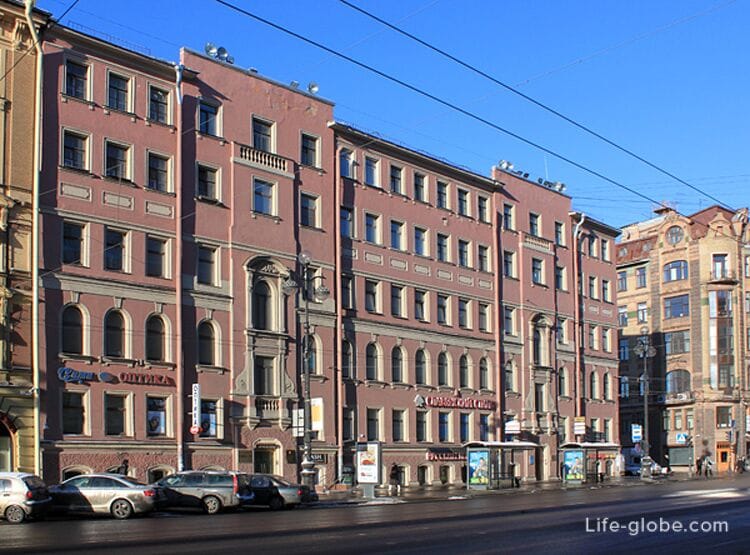
153 Nevsky Prospekt
It was also an apartment building of the Alexander Nevsky Lavra.
Construction - in 1901-1903 by civil engineers Shishko Lev Petrovich and Vincent A.A.
This long, five-story building is designed in an eclectic style and stands out with massive bay windows on the second and fourth floors and balconies above the bay windows on the fifth floor.
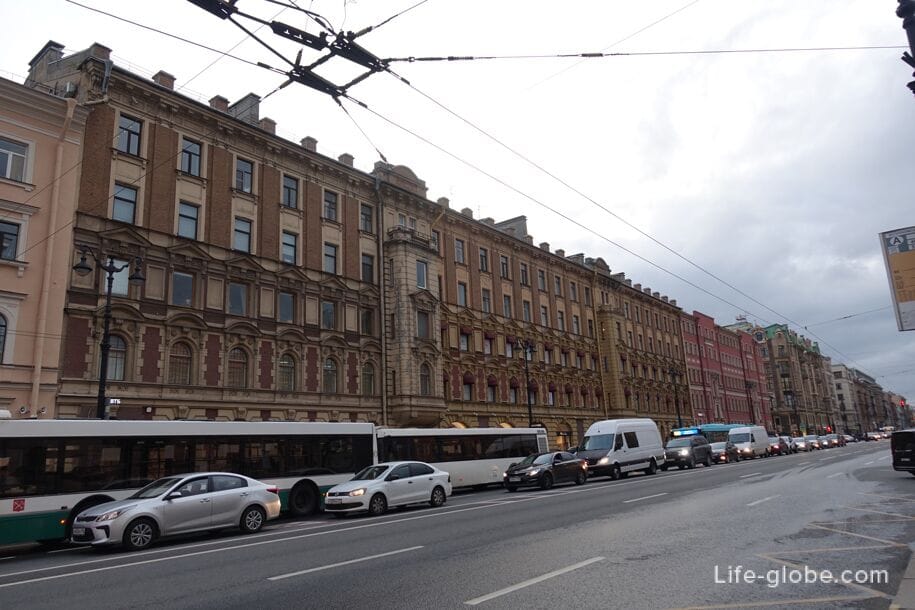
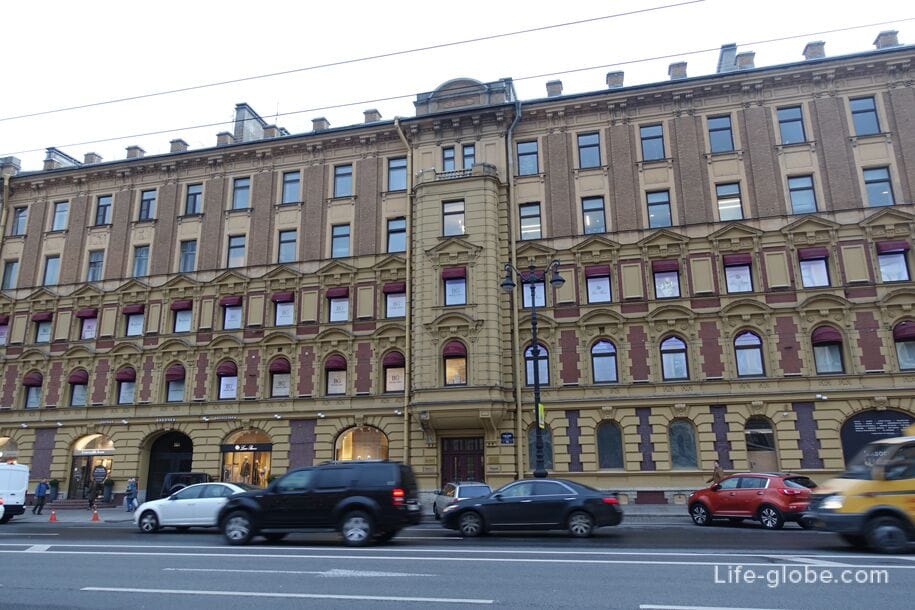
Nevsky Prospekt 163
The building was built in 1894 as an apartment building. The house was later added to.
The second floor of the building is distinguished by semicircular windows, and at the level of the fourth floor there are 4 balconies.

Gymnasium No. 168 of the Central District (169 Nevsky Prospekt)
The building at 169 Nevsky Prospekt is located in the depth of the plot. It was built in 1937 by architects Assom Leonid Evgenievich and Ginsberg Alexander Solomonovich.
For several months, the Institute of the Peoples of the Far North was located in this building. But the first students of the future Gymnasium were the children of the Spanish communists.
During the war, the building first housed the headquarters of the people's militia of the Smolninsky district, and then a military hospital. After the war, the partially destroyed building was restored and on September 1, 1949, children began to study in the building again - a seven-year school for boys was opened.
In 1950, the school became a ten-year school. In 1954, the school began to teach boys and girls (co-educational). In 1995, it became a gymnasium, and since 2000-gymnasium No. 168, English, German.
The building has a Stalinist neoclassical style.
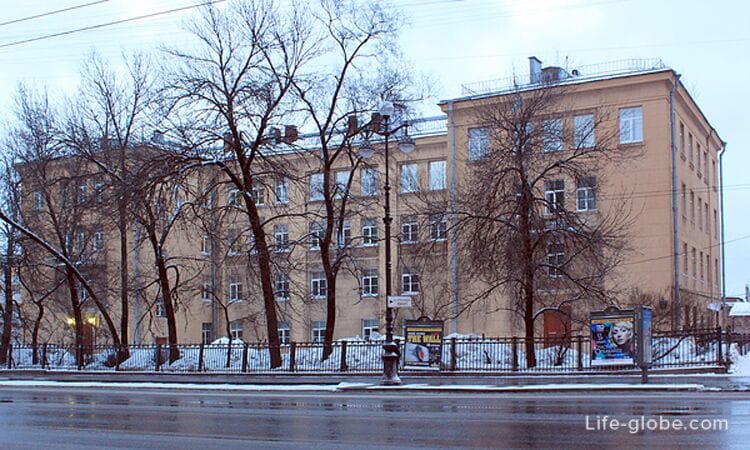
Nevsky Prospekt 171-173
The building is known as the residential building of the Alexander Nevsky Lavra. It was built in 1868 by Grigory Ivanovich Karpov; later it was built over.
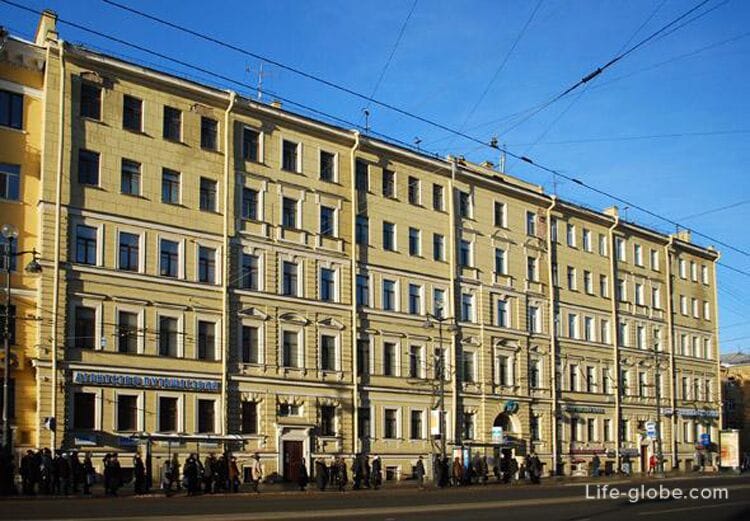
175 Nevsky Prospekt
The current house was built in 1947 by the architect D. S. Goldgor in accordance with the detailed layout of Alexander Nevsky Square developed at the same time.
Later, the house was restored and added to.
The five-story building of a strict noble appearance is made in the style of Stalinist classicism.
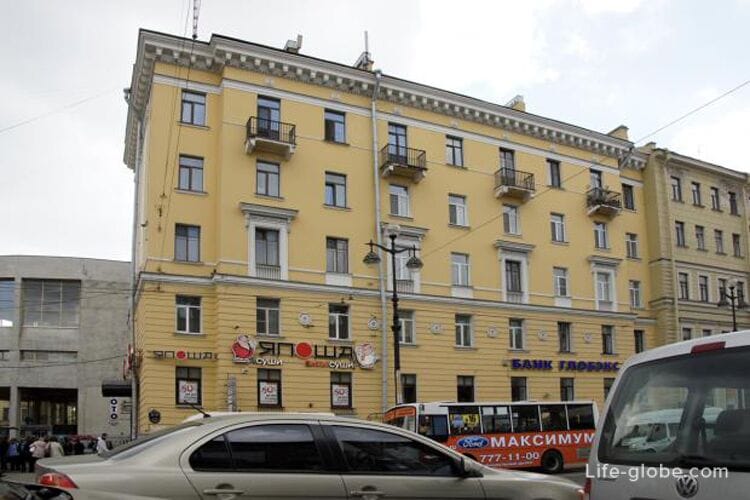
177 and 190 Nevsky Prospekt
Small, pretty buildings on Nevsky Prospekt 177 and 190 are located opposite each other and are known as residential buildings of the Alexander Nevsky Lavra.
These stone houses built in the 18th century (presumably built in 1788-1790 by the architect I.E. Starov) began the road from the Alexander Nevsky Monastery along Nevsky Prospekt to the city center.
House number 177 in the 1850s belonged to the monastery minister Ivan Fedorovich Yakovlev, then used for temporary housing of employees of the Lavra and spiritual educational institutions.
In the house No. 190 there were living quarters of the parish church of the Mother of God of All the Sorrowful Joy. In 1898, a priest of the Church of the Holy Twelve Apostles, an employee of the Church of the Holy Apostles, lived in the house.Of the St. Petersburg Spiritual Censorship Committee and the Theological Academy Mikhail Ivanovich Orlov, and in 1909 - the widow of Archpriest Pavel Vasilyevich Nilsky Lyubov Fyodorovna.


On these two small buildings, the magnificent and majestic Nevsky Prospekt ends.
Alexander Nevsky Square
The end of Nevsky Prospekt marks Alexander Nevsky Square, the center of which is decorated with a monumental equestrian monument to Grand Duke Alexander Nevsky, installed in 2002-the 300th anniversary of St. Petersburg.
On the square there are metro stations "Alexander Nevsky Square". Learn more about Alexander Nevsky Square and metro stations…
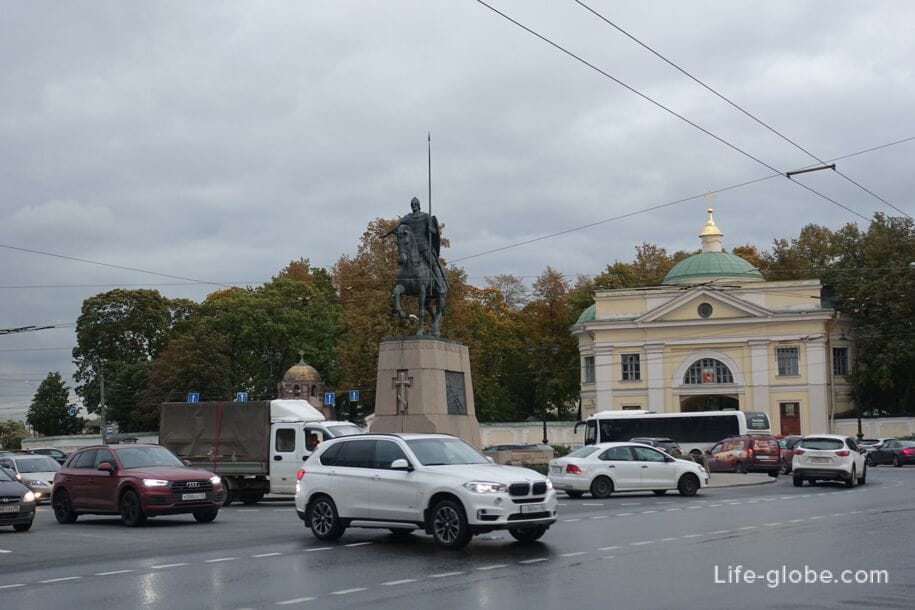
On the north-eastern side of the square stands a shopping center and a hotel - the 4-star Hotel Moscow, some rooms of which offer views of the Neva River and the Alexander Nevsky Lavra.
The seven-storey building of the hotel was built in 1974-1979 according to the project of the group under the leadership of D.S. Goldgor. In 2005-2007, the building was reconstructed according to the project of architects V.M. Freifeld and D.B. Sedakov, as a result of which the facades were changed, the building received an attic floor, and inside, in addition to the hotel, there is also a shopping center.
In the hotel: restaurants, including panoramic restaurant beef bar, free Wi-Fi, spa and wellness center, private Parking. On the floors there are coolers with hot and cold drinking water.
Each roomhere will provide you with a refrigerator, air conditioning, a free safety deposit box and free toiletries. Most rooms have an electric kettle.
Breakfast is included in the room rate. Link to the hotel
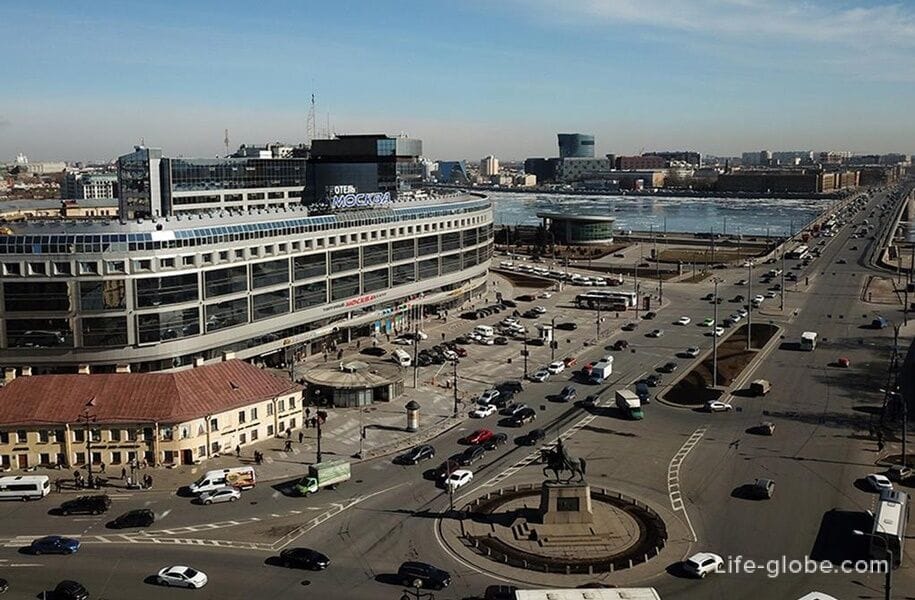
From Alexander Nevsky Square begins a monumental and voluminous monastic complex - The Holy Trinity Alexander Nevsky Lavra is a male Orthodox monastery, which was founded in 1710 and dedicated to the holy Prince Alexander Yaroslavich Nevsky, and which was granted the status of a Lavra in 1779.
Today, the monastery complex includes: the Holy Trinity Cathedral, the Alexander Nevsky Church and several other churches, cemeteries (now necropolises), buildings for various purposes, including monastic buildings, as well as a garden, monuments and museums.
Entrance to the territory of the complex, to the Holy Trinity Cathedral and churches is free (free of charge). The fee is charged for visiting the hotel museums located on the territory of the Lavra. Read more about the Holy Trinity Alexander Nevsky Lavra…
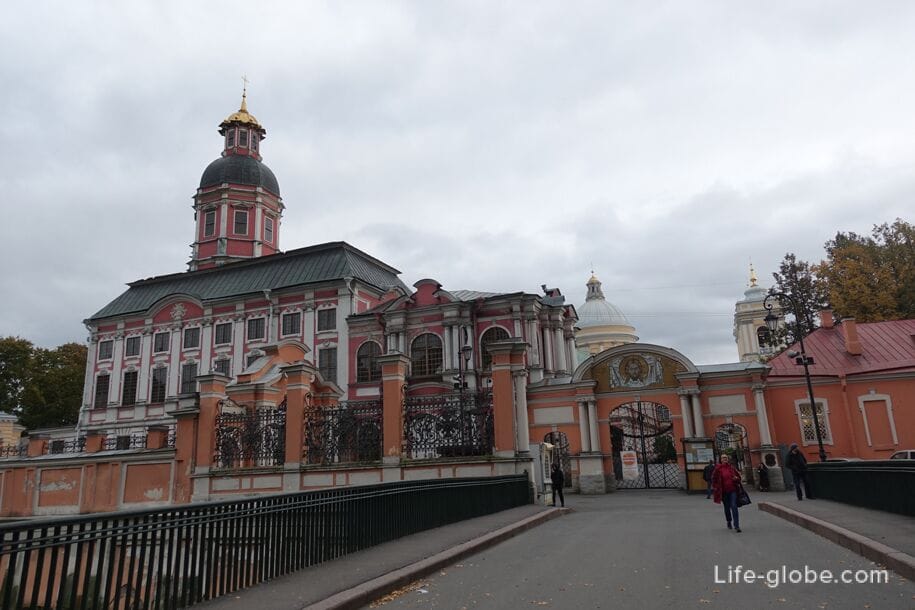
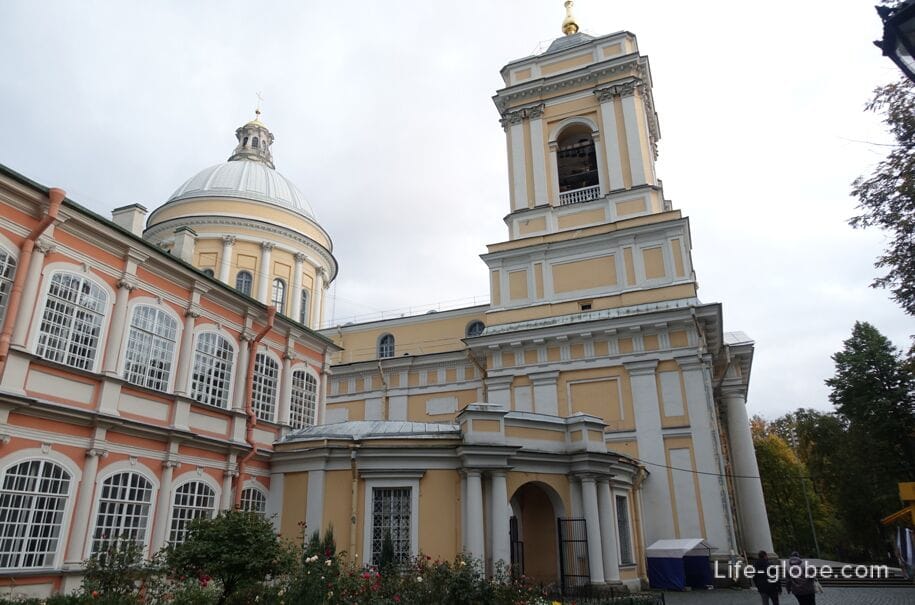
Practical information
Metro stations on Nevsky Prospekt and near the avenue: "Admiralteiskaya", "Nevsky Prospekt", "Gostiny Dvor", "Mayakovskaya", "Ploshchad Vosstaniya" and "Alexander Nevsky Square".
Public buses and trolleybuses run along Nevsky Prospekt and near the avenue.
You can visit Nevsky Prospekt either on your own or with one of the city tours
All accommodation facilities in St. Petersburg, including in the city center and on Nevsky Prospekt, can be viewed and booked here




